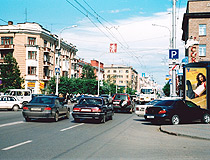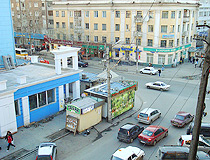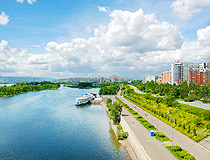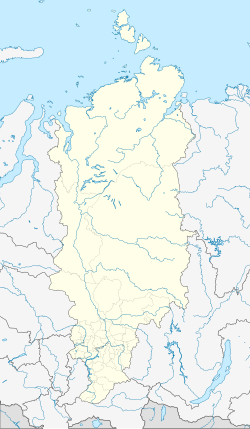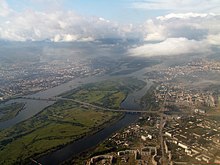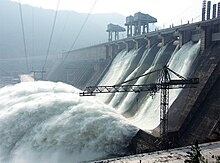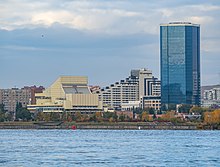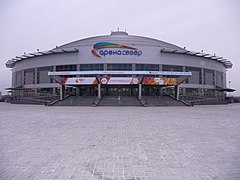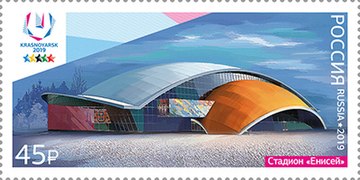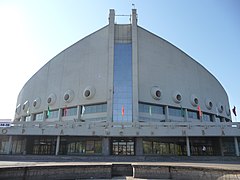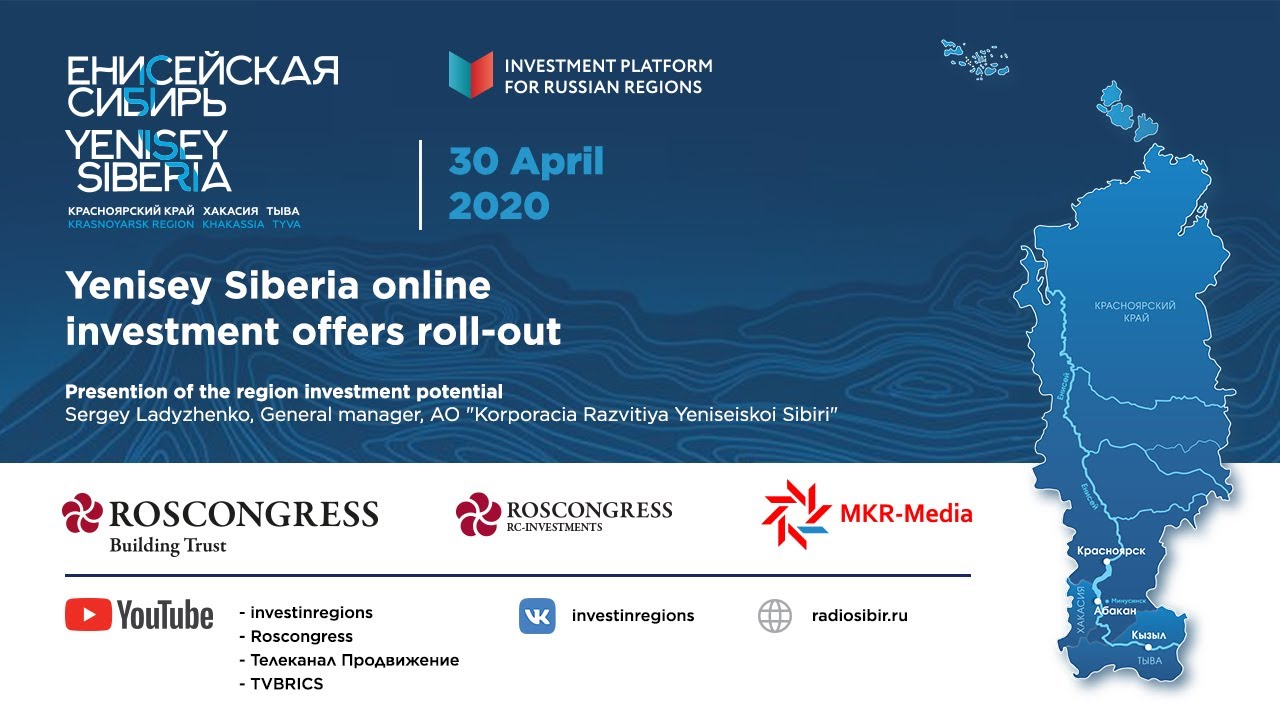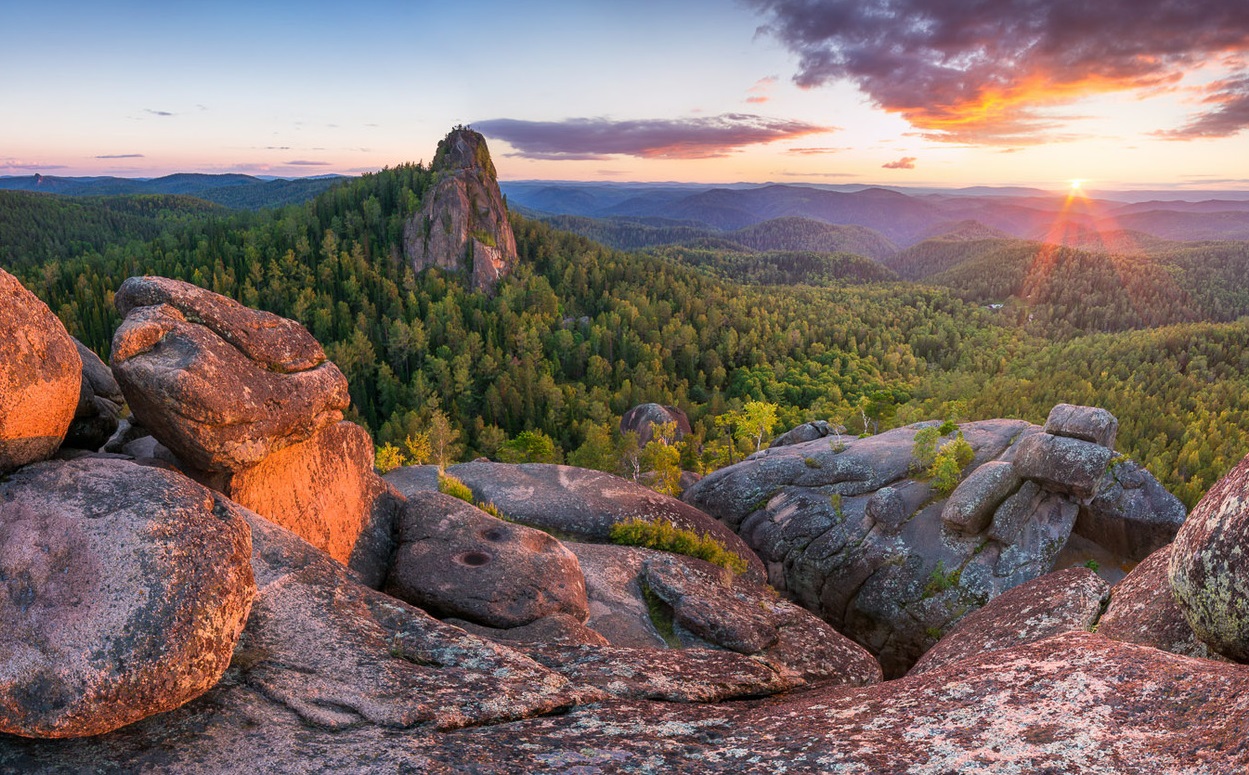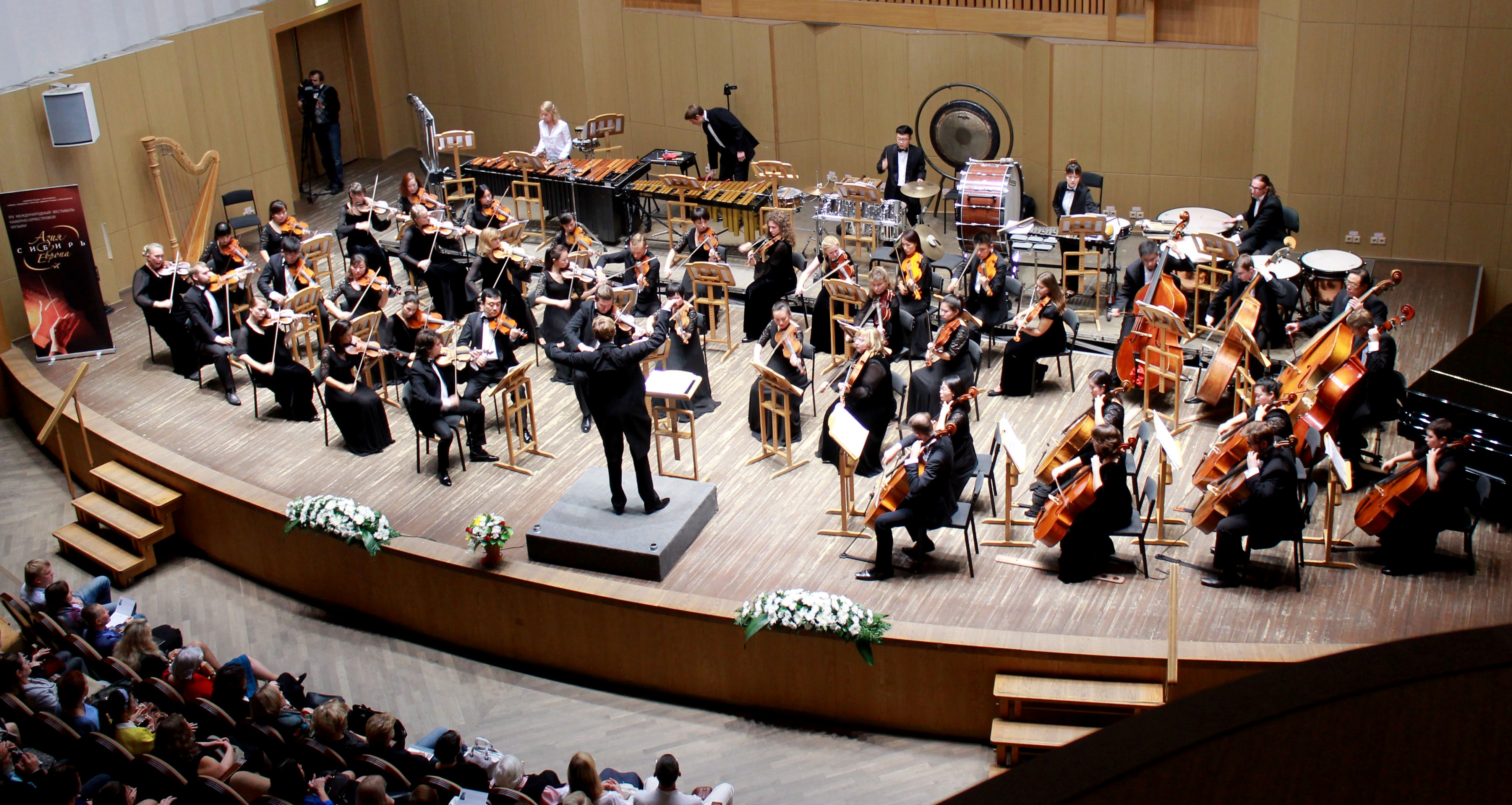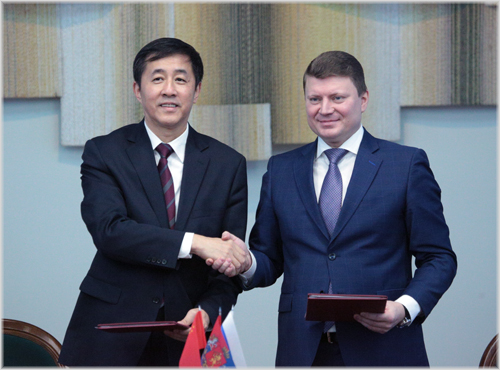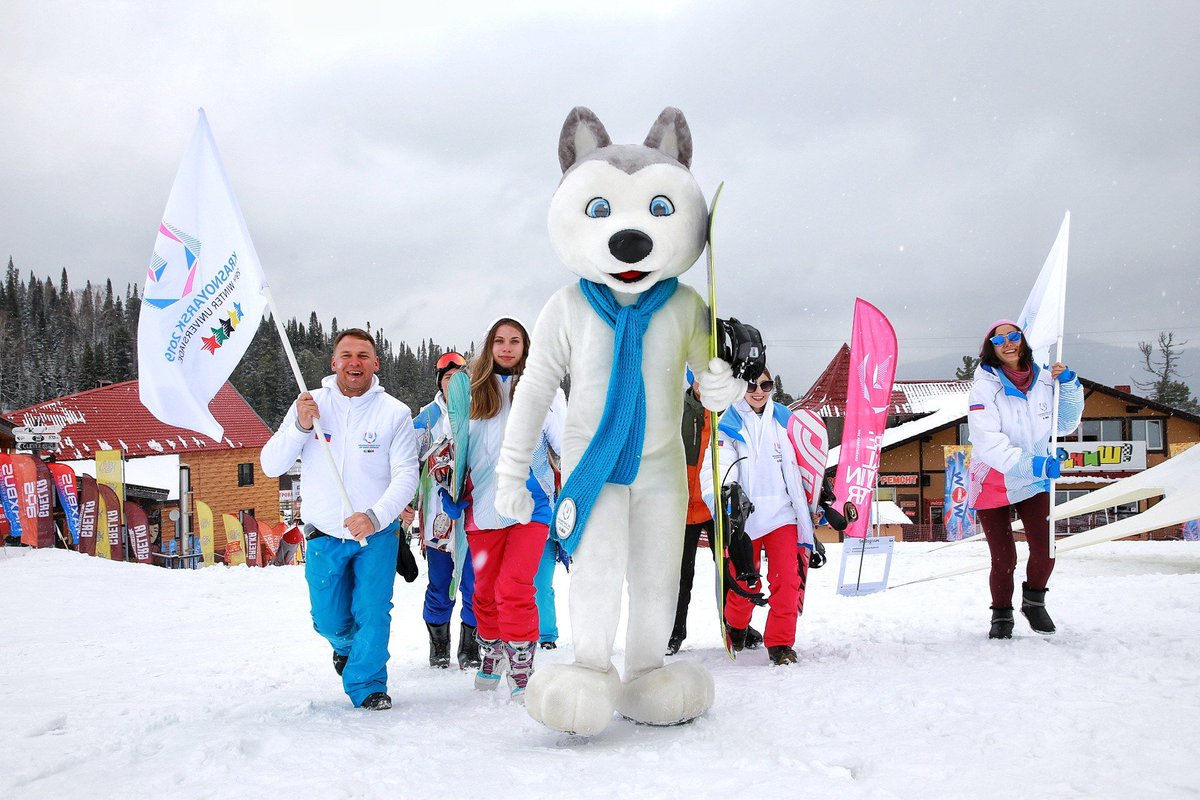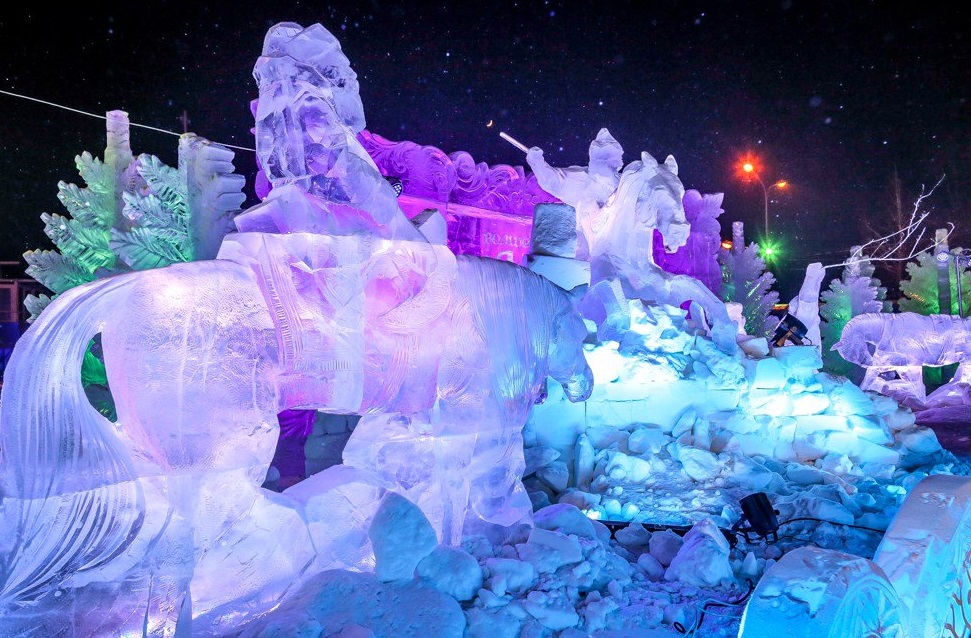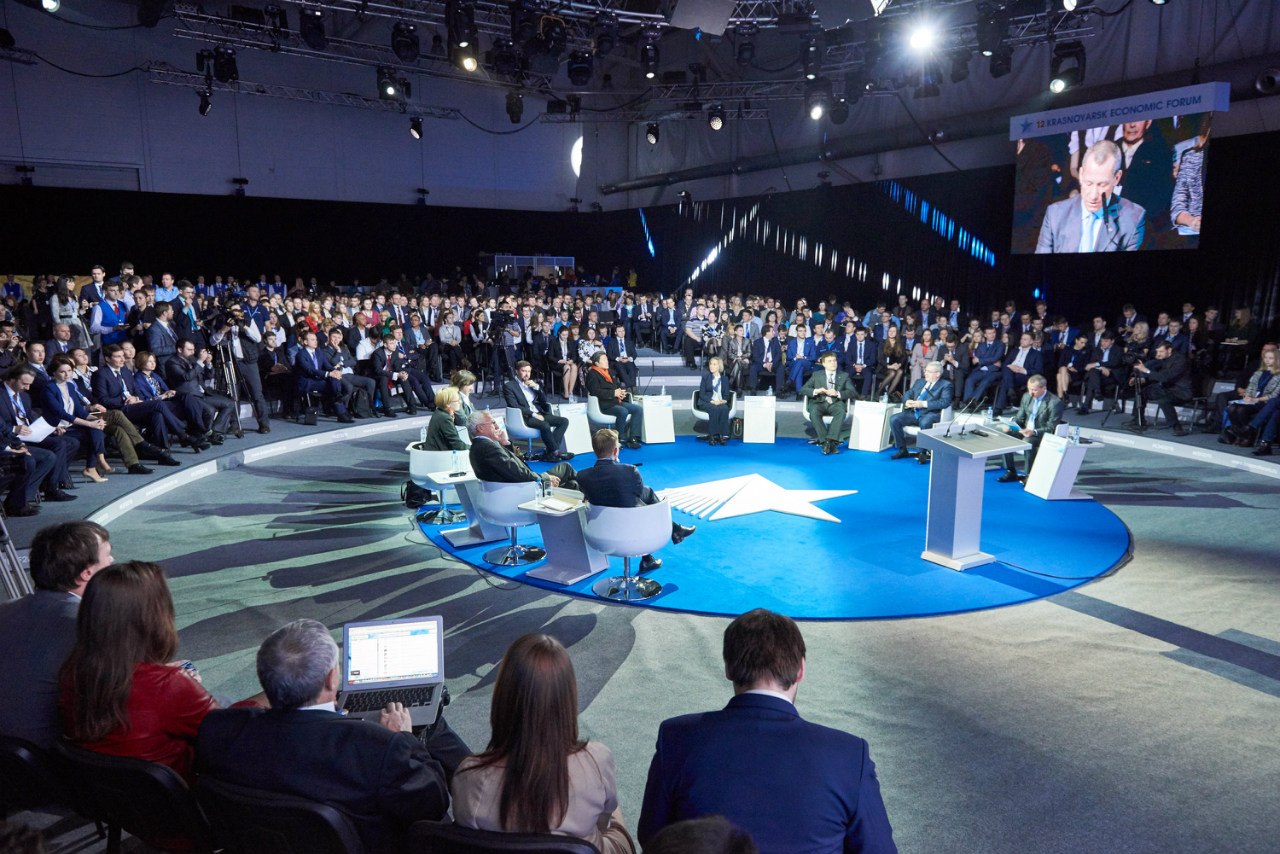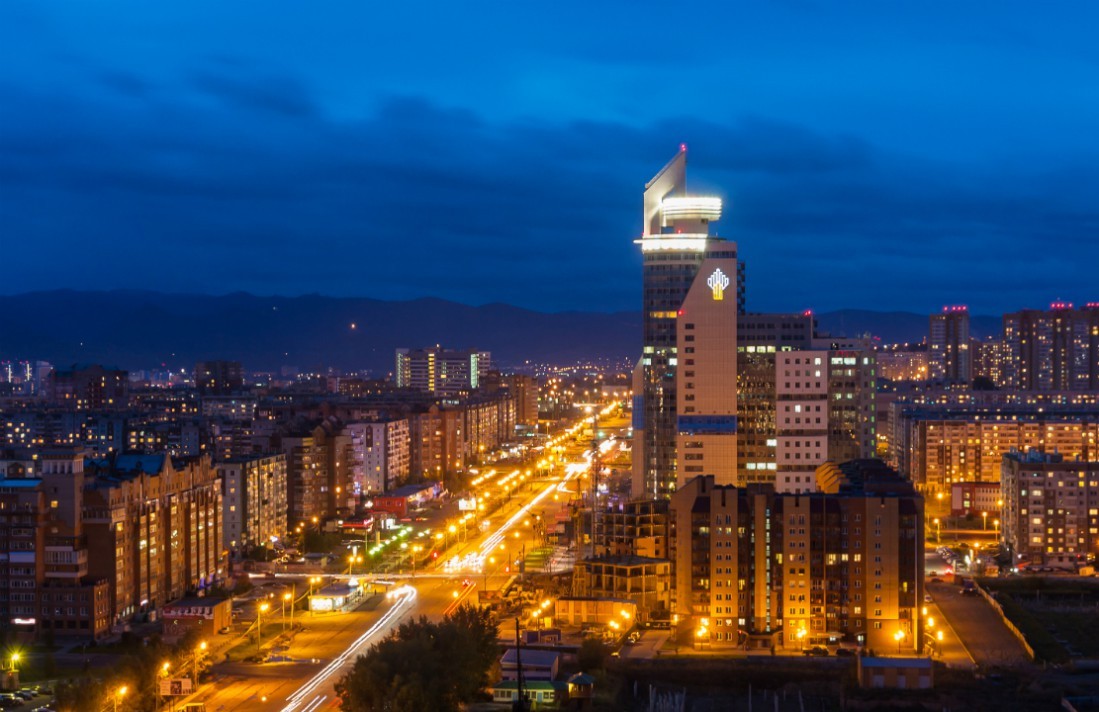Krasnoyarsk – was founded in 1628, is the largest cultural and economic center of Eastern and Central Siberia. – Красноярск – был основан в 1628 году, является самым крупным культурным и экономическим центром Восточной и Центральной Сибири.
Is the administrative center of Krasnoyarsk Krai, it is located on the Yenisei River. –
Является административным центром Красноярского края, расположен на реке Енисей.
The population makes more than one million people. – Население составляет более 1 миллиона человек.
From interesting features of climate: – Из интересных особенностей климата:
The winter is characterized by rather frosty weather, and summer – warm, but rainy. -Зима характеризуется достаточно морозной погодой, а лето – теплое, но дождливое.
- Never the river Yenisei freezes – Никогда не замерзает река Енисей
- The city is surrounded from all directions by mountains – Город со всех сторон окружают горы
City sights: Достопримечательности города:
The reserve Krasnoyarsk “Columns” – the hallmark of the city, is the brightest natural place of interest of the city and its vicinities, attracts travelers from around the world. (Заповедник Красноярские «Столбы» – визитная карточка города, это самая яркая природная достопримечательность города и его окрестностей, привлекает путешественников со всего мира.)
Paraskeva Pyatnitsa Chapel is an orthodox chapel, is a symbol of the city and is located on the Guard mountain – the highest point of the city. (Часовня Параскевы Пятницы – это православная часовня, является символом города и расположена на Караульной горе – самая высокая точка города.)
Clock tower – the integral symbol of the city for those who in it was born and grew up. (Часовая башня – неотъемлемый символ города для тех кто в нем родился и вырос)
Krasnoyarsk Eyfelevaya a tower – the reduced copy of the Parisian tower, is one of architectural sights of the city, 80 cm 14 m high, is opposite to the French restaurant “Bonzjor” (Красноярская Эйфелевая башня – уменьшенная копия парижской башни, является одной из архитектурных достопримечательностей города, высотой 14 м 80 см, находится напротив французского ресторана «Бонжур»)
All-weather park of sport and leisure – Fanpark “the Beaver Ravine”, 5 ski slopes and an attraction Rodelban, in the summer – the swimming pool, attractions and the ropeway are opened in the winter. (Всесезонный парк спорта и отдыха – Фанпарк «Бобровый Лог» , зимой открыто 5 горнолыжных трасс и аттракцион Родельбан, летом – бассейн, аттракционы и канатная дорога.)
The island Tatyshev – the biggest island, from being within Krasnoyarsk, in this territory is the park of a sports and improving orientation. The area of the park is 150 hectares. (Остров Татышев – самый большой остров, из находящихся в черте Красноярска, на этой территории находится парк физкультурно-оздоровительной направленности. Площадь парка 150 га.)
The Rivers of Siberia fountain – is considered the most beautiful fountain of Krasnoyarsk, there is on the theater square, the central sculpture of the fountain – the father Yenisei, on each side sculptures – the girls representing inflows of Yenisei. (Фонтан «Реки Сибири» – считается самым красивым фонтаном Красноярска, находится на театральной площади, центральная скульптура фонтана –батюшка Енисей, по бокам скульптуры – девушки, изображающие притоки Енисея.)
The Troitsk cemetery and the Holy Trinity Cathedral located in its territory is the museum under the open sky in which the mass of architectural monuments, and also burials of celebrated personalities. (Троицкое кладбище и расположенный на его территории Свято-Троицкий Собор – это музей под открытым небом, в котором масса архитектурных памятников, а также захоронения известных личностей.)
Krasnoyarsk Regional Museum of Local History – the known cultural center, one of the oldest museums in Siberia and Russia, the presented exposition widely shows life and tenor of life in Krasnoyarsk. (Красноярский краевой краеведческий музей – известный культурный центр, один из старейших музеев в Сибири и России, представленная экспозиция широко показывает быт и уклад жизни в Красноярске.)
Central Park of Culture and Leisure of A. M. Gorky – is on the left coast of Yenisei in a historical part of the city, the area of the park of 15 hectares, in the park there are a lot of attractions for adults and children, and also monuments such as: a monument to Pushkin, to M. Gorky, a monument to the worker of education, the forged bench “Traveller” and others. (Центральный парк культуры и отдыха им. А.М. Горького – находится на левом берегу Енисея в исторической части города, площадь парка 15 га, в парке много аттракционов для взрослых и детей, а также памятников таких как : памятник Пушкину, М. Горькому, памятник работнику просвещения , кованная скамья «Путник» и другие.)
Also in the city still a set of interesting places for visit such as interactive museum of science – Newton the park, the literary museum of V. P. Astafyev, the Krasnoyarsk art museum of V. I. Surikov – the unique place for fans of art, the museum of geology of the Central Siberia “Geos” and others. (Также в городе еще множество интересных мест для посещения таких как интерактивный музей науки – Ньютон парк, литературный музей им. В.П. Астафьева, красноярский художественный музей им. В.И. Сурикова – уникальное место для любителей искусства, музей геологии Центральной Сибири «Geos» и другие.)
Представлено сочинение на английском языке Красноярск — мой родной город/ Krasnoyarsk My Native City с переводом на русский язык.
| Krasnoyarsk My Native City | Красноярск — мой родной город |
| My name is Andrew. I’m fifteen years old and I study at the ninth form of the state secondary school. I was born and raised in Krasnoyarsk. It’s a large city and administrative center situated in Central and Eastern Siberia on the Yenisei River. | Меня зовут Андрей. Мне пятнадцать лет и я учусь в девятом классе средней общеобразовательной школы. Я родился и вырос в Красноярске. Это большой город и административный центр, расположенный в Центральной и Восточной Сибири на реке Енисей. |
| The city is notable for its natural landscapes and I’m very proud of that. Many people who have visited it state that it’s one of the most beautiful cities of Russia and certainly the most interesting city in Siberia. It is also an important junction of Trans-Siberian Railway. The total population is almost one million, at the moment perhaps even more. I love my home city very much for its beauty and abundance. | Город примечателен своими природными ландшафтами, и я очень горжусь этим. Многие люди, побывавшие в нем, утверждают, что это один красивейших городов России и, конечно, самый интересный город Сибири. Он также является важным узлом Транссибирской железной магистрали. Общая численность населения составляет почти один миллион человек, в настоящее время, возможно, даже больше. Я люблю свой родной город за красоту и благодатность. |
| There are so many interesting places to visit: museums, theatres, exhibition halls, architectural sights, etc. One of the places I recommend for visiting is the national nature reserve called “Stolby”. Its striking beauty leaves a lasting impression. It is full of forest paths, rocks for climbing, nice promenades. In the summer I like walking at the bank of the River Yenisei. Apart from being picturesque, it has lots of useful functions, for example, ferry and barge crossings. | Здесь так много интересных мест для посещения: музеи, театры, выставочные залы, архитектурные достопримечательности, и т.д. Одно из мест, которое я рекомендую к посещению, это национальный заповедник под названием «Столбы». Его поразительная красота оставляет неизгладимое впечатление. Он полон лесных тропинок, скал для альпинизма, дорожек для прогулок. Летом я люблю ходить по набережной реки Енисей. Помимо того, что она достаточно живописная, у нее множество полезных функций, например, паромные и баржевые переправы. |
| Many outstanding Russian people grew up in Krasnoyarsk, among them Vasily Surikov, Viktor Astafyev. The city is an ideal place for students, as there are lots of educational institutions. The locals call it “the city of fountains” for their presence nearly in every district. Krasnoyarsk is especially picturesque during the holidays. For example, at New Year it is illuminated by thousands of electric lights. | Многие выдающиеся русские люди выросли в Красноярске, среди них Василий Суриков, Виктор Астафьев. Город является идеальным местом для студентов, так как в нем много учебных заведений. Местные жители называют его «городом фонтанов» за их присутствие почти в каждом районе. Красноярск особенно живописен во время праздников. Например, на Новый год он освещается тысячами электрических лампочек. |
History of Krasnoyarsk
Foundation of Krasnoyarsk
Krasnoyarsk is one of the oldest cities in Siberia. People began to settle in the territory of Krasnoyarsk from the Upper Paleolithic era (about 28-32 thousand years ago). Before the arrival of the Russians, it was part of the Yezher Principality of the Yenisei Kyrgyz.
This area became known to the Russians in 1608, when the Cossacks went up the Yenisei River with the intention of finding new lands and annexing them to the possessions of the Moscow Tsar. Local tribes refused to pay yasak (tribute) to the Russians and bothered them with raids. Therefore, the Cossacks decided to turn to the Yenisei voivode with a request for help and protection.
The Yenisei voivode Yakov Khripunov sent a nobleman Andrei Dubensky to inspect the land occupied by the Cossacks and find a place to build a fortified settlement. Dubensky found it at the confluence of the Kacha River into the Yenisei, made a plan, and with it went to Moscow. The presented plan was approved and he was allowed to proceed with the construction of the settlement.
At the end of 1627, after returning from Moscow, Dubensky with three hundred Cossacks left Yeniseisk to found a new fortified settlement. On August 19, 1628, the construction of a small fort called “Krasnyy Yar” (literally meaning “red steep bank”) was completed below Krasnoyarsk, opposite Tatyshev Island. It was named after the red color of marl of the left high bank of the Kacha River. This day is considered the day of foundation of Krasnoyarsk.
More Historical Facts…
Initially, the most important function of the fort was the defense of the main Russian settlements of Siberia from the south. The Yenisei Kyrgyz and tribes subordinate to them repeatedly attacked the fort of Krasnyy Yar and the villages located next to it. The most devastating raids were in 1630, 1634, 1635, 1636, 1640, 1665, 1667, and 1679.
In 1673, Krasnoyarsk under the name “Krasnagair” was first mentioned in Western European literature — in “The Description of Siberia” by German author Albrecht Dobbin. In 1690, the settlement was granted town status.
Krasnoyarsk in the 18th-19th centuries
In 1708, the population of Krasnoyarsk was 849 people. In 1713, 1,295 men and 1,217 women lived in it. After the defeat of the Yenisei Kyrgyz, the departure of their princes to the foothills of the Tien Shan, the construction of the Abakan and Sayan forts, and the signing of the Kyakhta peace with Manchuria in 1728, Krasnoyarsk lost its strategic importance as a military outpost.
In 1733-1734, Vitus Jonassen Bering, a Danish cartographer and explorer in Russian service, lived in Krasnoyarsk procuring provisions and equipment for his expedition. The gradual growth of Krasnoyarsk began, when the Siberian Route reached it in 1735 (the federal highway R255 “Siberia”). This road connected Krasnoyarsk with Achinsk, Kansk, and other parts of the Russian Empire.
In 1772, the population of Krasnoyarsk was only about 2 thousand people, it remained a small district town. In 1734-1743, the German natural scientist and traveler Johann Georg Gmelin lived and worked in Krasnoyarsk. In 1756, an ironworks was founded near the town.
In 1771-1773, the famous Prussian zoologist and botanist Peter Simon Pallas visited Krasnoyarsk three times. Here he discovered a 680-kilogram meteorite fragment named “Krasnojarsk”. It was the first meteorite discovered in Russia and the first pallasite meteorite ever found.
After the fire of 1773, there were only thirty houses left in Krasnoyarsk. The geodesy sergeant Pyotr Moiseev was sent to Krasnoyarsk from Tobolsk to draw up a new linear layout for the town on the model of St. Petersburg. This became the beginning of today’s Krasnoyarsk.
The life of the town changed when the Yenisei Governorate was created in 1822. Krasnoyarsk was chosen as its center. It was not the largest town in the region, but it occupied the most favorable economic and geographical position. The town was one of the places of political exile. Eight Decembrists were exiled to Krasnoyarsk after the suppression of the 1825 uprising.
In 1834, a town garden (present Central Park) was laid out in Krasnoyarsk. In 1846, a public library was opened. In 1856, the population of Krasnoyarsk was about 6,400 people. In 1863, shipping began along the Yenisei. At the same time, a telegraph station began operating in the town. In 1889, the town public museum was opened in Krasnoyarsk, as well as the first medical assistant school in Siberia.
In 1894, the first technical railway school in Siberia was opened in Krasnoyarsk. Further growth of the town was connected with the discovery of gold in the region and the advent of the railway in 1895. The supply of rails for the construction of the Trans-Siberian Railway was carried out by the Northern Sea Route. In 1897, the population of Krasnoyarsk was about 26,700 people.
Krasnoyarsk in the 20th century and beyond
In 1908, the first stationary movie theater was opened in Krasnoyarsk. In 1912, the first power station was commissioned. In 1913, the first city water supply system was built. In September 1913, the Norwegian explorer Fridtjof Nansen stayed in Krasnoyarsk making a trip to Eastern Siberia and the Far East. His goal was to establish permanent trade relations with Central Siberia by sea through the Kara Sea and the Yenisei River.
During the First World War, one of the largest prisoners of war camps in the Russian Empire was organized in Krasnoyarsk. By the end of 1915, there were about 13 thousand prisoners of war in it. In 1920, Maria Bochkareva, the creator of the first women’s battalion in the history of the Russian army, was sentenced to death in Krasnoyarsk because of her active involvement in the fight against the Bolsheviks. In 1923, the population of Krasnoyarsk was 59,258 people.
In 1934, Krasnoyarsk became the administrative center of Krasnoyarsk Krai. In 1939, there were 189,977 residents in this city. By the beginning of 1941, about 39,000 people worked at all industrial enterprises of Krasnoyarsk.
During the Second World War, a number of factories from European Russia were evacuated to the city. The Alsib (Alaska-Siberia) air route passed through Krasnoyarsk. It was used as a stop by military aircraft sent from the USA and the aircraft factories of Irkutsk, Ulan-Ude, Komsomolsk-on-Amur. During the war years, the industrial power of Krasnoyarsk increased by 7 times. It became the main industrial center of Eastern Siberia.
The development of the hydropower resources of the Angara and the Yenisei, which began in the postwar years, became a new page in the history of Krasnoyarsk. During this period of industrial growth, not only a powerful electric power industry was created, but also large enterprises of the ferrous and non-ferrous metallurgy, pulp and paper, medical and chemical industries were built.
Krasnoyarsk also became a major center of academic science, higher and secondary specialized education. In 1989, the population of Krasnoyarsk was about 912,000 people. After the collapse of the USSR, the city experienced depopulation, its population decreased by about 10%. However, at the end of the 20th century, the population of the city again began to constantly grow.
In 1995, the construction of the Krasnoyarsk metro was started. Several times the construction was stopped due to lack of funds. It is planned that the metro will be open in the mid-2020s.
In 2006, the first of the Russian federal universities, the Siberian Federal University, was established in this city. In 2012, Krasnoyarsk became the 14th city in Russia with a population of more than 1 million people. In 2019, the XXIX World Winter Universiade 2019 was held in the city.
Streets of Krasnoyarsk
Street traffic in Krasnoyarsk
On the street in Krasnoyarsk
Author: Andrey Pivovarov
Embankment along the Yenisei River in Krasnoyarsk
Author: Dmitry Antipov
Krasnoyarsk — Features
Krasnoyarsk, located in the forest-steppe zone and in mountainous areas on both banks of the Yenisei River in central Russia, is unofficially called the capital of Siberia. Founded in 1628, it is the largest of the old cities of Siberia. Krasnoyarsk is the easternmost city with a population of more than 1 million people in Russia.
The Yenisei divides Siberia into Western and Eastern, and the city itself is roughly divided by it in half. Krasnoyarsk is one of the most compact million-plus cities in Russia. From west to east, the length of the city is about 41 kilometers, from north to south — almost 37 kilometers.
The lion depicted on the coat of arms of Krasnoyarsk holds a shovel and sickle in its paws — symbols of gold mining and agriculture. Today, about 20% of all gold in Russia is mined in Krasnoyarsk Krai.
The climate of Krasnoyarsk is continental, moderated by large masses of water (Krasnoyarsk reservoir), the ice-free Yenisei, and the surrounding mountains. Winter is not snowy, with frequent thaws. The average temperature in January is minus 15.5 degrees Celsius, in July — plus 18.7 degrees Celsius.
Krasnoyarsk is a developed center of industry in Russia. On the territory of the city there are more than 17,000 enterprises, organizations, institutions. The leading industries are space industry, non-ferrous metallurgy, mechanical engineering, woodworking, transportation, chemical, food, retail and wholesale, services.
This city is a major transit hub of Eastern Siberia located at the intersection of the Trans-Siberian Railway and historical trade routes along the Yenisei River. The federal highway “Siberia” R255 Novosibirsk — Krasnoyarsk — Irkutsk, which is part of the Moscow — Vladivostok route, passes through the city.
The international airport of Krasnoyarsk offers regular flights to Vladivostok, Irkutsk, Kazan, Krasnodar, Moscow, Novosibirsk, Norilsk, St. Petersburg, Sochi, Surgut, Tomsk, Khabarovsk, Chelyabinsk, Chita, Yakutsk, and a number of other cities.
Krasnoyarsk is also a large scientific, educational, and sports center of Russia. At the Siberian Federal University alone, over 40,000 students are studying. In total, there are more than 150,000 students in the city.
The design of the Russian 10 ruble banknote is dedicated to Krasnoyarsk. On it you can see the Paraskeva Pyatnitsa Chapel, the Communal Bridge, and the Krasnoyarsk Hydroelectric Power Station. Today, these banknotes are almost completely withdrawn from circulation.
Main Attractions of Krasnoyarsk
Stolby Nature Reserve — a natural area located on the northwestern spurs of the Eastern Sayan Mountains limited by the right tributaries of the Yenisei River and starting within the city limits of Krasnoyarsk. Here you can see unique rock formations, which are called “stolby” (“pillars”). The flora of the reserve is the dense Siberian taiga. There is a large tourist area with hiking and sports routes.
The Paraskeva Pyatnitsa Chapel (1852-1855) — an Orthodox church standing on Karaulnaya Mount, one of the symbols of Krasnoyarsk. The first chapel at this place was built of wood and also served as a guard tower. The stone structure was erected at the expense of the gold miner Pyotr Kuznetsov. Stepana Razina Street, 51.
The Flora and Fauna Park “Royev Ruchey” — one of the largest Russian zoos covering an area of 31 hectares and located on the southwestern outskirts of Krasnoyarsk. Its collection is second only to the Moscow Zoo in diversity. Here you can see the largest collection of African mammals in Siberia. There is also a separate huge aquaterrarium, the only penguinarium east of the Urals, and aviaries with polar bears.
Tatyshev Island — the largest island on the Yenisei River within Krasnoyarsk connected to the city by two bridges. Today, it is a recreation area where you can walk, run, ride a bicycle, roller skates, etc. There is a beach, a picnic area, and an arboretum.
Krasnoyarsk Museum of Local Lore — one of the oldest museums in Siberia and the Far East, one of the largest museums in Russia. The museum building was constructed in the Art Nouveau style and is vaguely reminiscent of an Egyptian temple.
The exposition reflects the history of this huge region from ancient times to the present. Here you can see archaeological, paleontological, art, ethnographic, natural science collections of world significance. Dubrovinskogo Street, 84.
The Vasily Surikov Art Museum — one of the most significant collections of fine art east of the Urals. In total, there are more than 15 thousand works of art. The building of the museum is an object of cultural heritage of the peoples of Russia. The famous Russian artist Vasily Surikov was born in Krasnoyarsk. Parizhskoy Kommuny Street, 20.
The Vasily Surikov Museum-Estate. This museum occupies the house where Vasily Surikov lived. It is a wooden manor of the 1830s built of larch — a typical example of urban construction of the 19th century. The collection has more than 90 works of Surikov himself, as well as interior items and belongings of the artist’s family. Lenina Street, 98.
Literary Museum named after V.P. Astafyev. The museum collection is housed in a picturesque 19th-century mansion built of wood in the Art Nouveau style with Gothic motifs. Today, this building is an architectural monument of federal significance, one of the most beautiful buildings in Krasnoyarsk. Lenina Street, 66.
Steamboat-Museum “Saint Nicholas” — a museum-ship located on the Yenisei embankment. This passenger and cargo river boat was produced at a shipyard in Tyumen in 1886. In the 1950s, the ship was decommissioned. The museum exposition was opened after the overhaul of the ship in the 1970s. Mira Square, 1a.
Holy Intercession Cathedral (1785-1795) — an architectural monument of the Yenisei school of Siberian Baroque, the oldest surviving stone building in Krasnoyarsk. Surikova Street, 26.
Annunciation Church (1804-1812) — a grandiose church built at the junction of two eras and architectural styles — Baroque and Classicism. Its design was developed not by professional architects, but by Tobolsk craftsmen, who made iconostases. Lenina Street, 15.
The Catholic Church of the Transfiguration of the Lord (1909-1911) — a red brick building with elements of the Gothic style. In 1982, the organ hall of the local philharmonic was opened in the building. In 1993, Catholic services were resumed. Dekabristov Street, 20.
|
Krasnoyarsk Красноярск |
|
|---|---|
|
City[1] |
|
|
Top to bottom, left to right: Krasnoyarsk along the Yenisey River, Krasnoyarsk at dusk, Krasnoyarsk railway station, Annunciation Cathedral, Krasnoyarsk Krai government building |
|
|
Flag Coat of arms |
|
|
Location of Krasnoyarsk |
|
|
Krasnoyarsk Location of Krasnoyarsk Krasnoyarsk Krasnoyarsk (Krasnoyarsk Krai) |
|
| Coordinates: 56°00′32″N 92°52′19″E / 56.00889°N 92.87194°ECoordinates: 56°00′32″N 92°52′19″E / 56.00889°N 92.87194°E | |
| Country | Russia |
| Federal subject | Krasnoyarsk Krai[1] |
| Founded | August 19, 1628[2] |
| City status since | 1690[3] |
| Government | |
| • Body | City Council of Deputies[2] |
| • Head[2] | Sergey Yeryomin[4] |
| Area
[5] |
|
| • Total | 348 km2 (134 sq mi) |
| Elevation | 287 m (942 ft) |
| Population
(2010 Census)[6] |
|
| • Total | 973,826 |
| • Estimate
(2018)[7] |
1,090,811 (+12%) |
| • Rank | 14th in 2010 |
| • Density | 2,800/km2 (7,200/sq mi) |
|
Administrative status |
|
| • Subordinated to | krai city of Krasnoyarsk[1] |
| • Capital of | krai city of Krasnoyarsk, Krasnoyarsk Krai[8] |
|
Municipal status |
|
| • Urban okrug | Krasnoyarsk Urban Okrug[9] |
| • Capital of | Krasnoyarsk Urban Okrug[9] |
| Time zone | UTC+7 (MSK+4 |
| Postal code(s)[11] |
660000, 660001, 660003–660005, 660006, 660009–660023, 660025, 660027, 660028, 660030–660032, 660036, 660037, 660041–660043, 660046–660050, 660052, 660054–660056, 660058–660062, 660064, 660067–660069, 660071, 660073–660075, 660077–660079, 660091–660095, 660097–660100, 660113, 660115, 660118, 660119, 660121–660127, 660130–660133, 660135, 660136, 660880, 660890, 660899, 660911–660946, 660960–660966, 660970, 660999, 901175, 901177, 901179, 901181, 993600 |
| Dialing code(s) | +7 391[12] |
| OKTMO ID | 04701000001 |
| City Day | Second Sunday of June[13] |
| Website | www.admkrsk.ru |
Krasnoyarsk ( KRA(H)SS-nə-YARSK;[14][15][16][17] Russian: Красноя́рск, IPA: [krəsnɐˈjarsk] (listen)) (in semantic translation — Red Ravine City) is the largest city and administrative center of Krasnoyarsk Krai, Russia. It is situated along the Yenisey River, and is the second-largest city in Siberia after Novosibirsk, with a population of over 1.1 million.[18] Krasnoyarsk is an important junction of the renowned Trans-Siberian Railway, and is one of the largest producers of aluminium in the country.
The city is known for its natural landscape; author Anton Chekhov judged Krasnoyarsk to be the most beautiful city in Siberia.[19] The Stolby Nature Sanctuary is located 10 km south of the city. Krasnoyarsk is a major educational centre in Siberia, and hosts the Siberian Federal University. In 2019, Krasnoyarsk was the host city of the 2019 Winter Universiade, the third hosted in Russia.
Geography[edit]
Aerial view of Krasnoyarsk
Church in Krasnoyarsk, 1895
The panorama of Krasnoyarsk from the Karaulnaya Gora hill, 1910
The total area of the city, including suburbs and the river, is 348 km2 (134 sq mi).[5]
The river Yenisei flows from west to east through the city. Due to the Krasnoyarsk hydroelectric dam 32 km (20 mi) upstream, the Yenisei never freezes in winter and never[citation needed] exceeds +14 °C (57 °F) in summer through the city. Near the city center, its elevation is 136 m (446 ft) above sea level. There are several islands in the river, the largest of which are Tatyshev and Otdyha Isles, used mainly for recreation.
To the south and west, Krasnoyarsk is surrounded by forested mountains averaging 410 m (1,350 ft) in height above river level. The most prominent of them are Nikolayevskaya Sopka (notable for its ski jumping tracks), Karaulnaya Gora, and Chornaya Sopka, the latter being an extinct volcano.[20] The gigantic rock cliffs of the Stolby Nature Reserve rise from the mountains of the southern bank of the Yenisei, the western hills from the Gremyachaya Griva crest extending westwards up to the Sobakina River, the north is generally plain, except for the Drokinskaya Sopka hill, with forests to the northwest and agricultural fields to the north and east.
The major rivers in and near Krasnoyarsk are the Yenisei, Mana, Bazaikha, and Kacha Rivers, the latter flowing throughout the historical center of the city. Due to the nature of the terrain, a few natural lakes exist in the vicinity of Krasnoyarsk.
The forests close to the city are mostly pine and birch; further afield, aspen becomes dominant in many areas. The moss-covered fir and Siberian pine replaces other wood in the mountains westward of the Karaulnaya River, in about 15 km (9.3 mi) to the west from the city, the forests to the south are mostly pine, fir and aspen.[21]
History[edit]
Monument to the Czecho-Slovak Legion in the Trinity Cemetery
The city was founded on August 19, 1628[2] as a Russian border fort when a group of service class people from Yeniseysk led by Andrey Dubenskiy arrived at the confluence of the Kacha and Yenisei Rivers and constructed fortifications intended to protect the frontier from attacks of native peoples who lived along the Yenisei and its tributaries. Along with Kansk to the east, it represented the southern limit of Russian expansion in the Yenisei basin during the seventeenth century. In the letter to Tsar Michael I the Cossacks reported:
- …The town of trunks (log buildings) we have constructed and around the place of fort, we the servants of thee, our Lord, have embedded posts and fastened them with double bindings and the place of fort have strengthened mightily…
The fort was named Krasny Yar (Russian: Кра́сный Яр) after the Yarin (a dialect of Khakas) name of the place it was built, Kyzyl Char (‘red steep-riverbank’),[22] which was translated as Krasny Yar. The settlement was granted town status in 1690.[23] An intensive growth of Krasnoyarsk began with the arrival of the Siberian Route (the road M53 nowadays) in 1735 to 1741 which connected the nearby towns of Achinsk and Kansk with Krasnoyarsk and with the rest of Russia.
In 1749, a meteorite with a mass of about 700 kg (1,500 lb) was found 230 km (140 mi) south of Krasnoyarsk. It was excavated by Peter Simon Pallas in 1772 and transported to Krasnoyarsk and subsequently to Saint Petersburg. The Krasnoyarsk meteorite is important because it was the first pallasite ever studied and the first meteorite ever etched.
In 1822 Krasnoyarsk became the administrative center of Yeniseysk Governorate.[23] By the end of the 19th century, Krasnoyarsk had several manufacturing facilities and railroad workshops and an engine-house. Growth continued with the discovery of gold and the arrival of a railroad in 1895.
In the Russian Empire, Krasnoyarsk was one of the places to which political exiles were banished. For example, eight Decembrists were deported from St. Petersburg to Krasnoyarsk after the failure of the revolt.
Krasnoyarsk hydroelectric dam
In the aftermath of the Russian Revolution of 1917, during the Russian Civil War, Siberia east of Omsk was controlled by white forces under Alexander Kolchak, who in December 1919 retreated east to Irkutsk and the Bolsheviks took control of the city. On a plateau 7 km outside of town was a prisoner of war camp with 13,000 German and Austrian troops. Elsa Brändström of the Swedish Red Cross spent almost a year there from July 1919 until May 1920.[24]
During the periods of centralized planning (Five Year Plans) numerous large plants and factories were constructed in Krasnoyarsk: Sibtyazhmash, the dock yard, the paper factory, the hydroelectric power station (now the fifth largest in the world and the second in Russia), and the river port.
In 1934, Krasnoyarsk Krai was formed, with Krasnoyarsk as its administrative center.
During Stalinist times, Krasnoyarsk was a major center of the gulag system. The most important labor camp was the Kraslag or Krasnoyarsky ITL (1938-c.1960) with the two units located in Kansk and Reshyoty. In the city of Krasnoyarsk itself, the Yeniseylag or Yeniseysky ITL labor camp was prominent as well during World War II (c. 1940–41).
During World War II, dozens of factories were evacuated from Ukraine and Western Russia to Krasnoyarsk and nearby towns, stimulating the industrial growth of the city. After the war additional large plants were constructed: the aluminum plant, the metallurgic plant, the plant of base metals and many others.
In the late 1970s, the Soviet Union began constructing a phased array radar station at Abalakova, near Krasnoyarsk, which violated the ABM Treaty. Beginning in 1983, the United States demanded its removal, until the Soviet Union admitted the radar station was a violation in 1989. Equipment was slowly removed from the site and by 1992 it was officially declared to be dismantled, though the equipment from the site was likely relocated to a new site near Komsomolsk-na-Amure.[25] Krasnoyarsk was also a home to Krasnoyarsk Northeast air base, which was turned into living blocks after the dissolution of the Soviet Union.
After the dissolution of the Soviet Union and beginning of privatization, many large plants and factories, such as the Krasnoyarsk Aluminum Plant, became owned by alleged criminal authorities and oligarchs, while others were declared bankrupt. The economic transition resulted in a dramatic rise in unemployment and numerous strikes.
The best known financial scandal of the second half of the 1990s happened when ownership of the Krasnoyarsk Aluminum Plant by a known Krasnoyarsk businessman Anatoliy Bykov had been canceled after he was accused of murdering his partner, Vilor Struganov. The accusation eventually turned out to be false.[26] The Krasnoyarsk plant’s ownership problems continue through the early 21st century since nearly all of them are owned either by monopolistic financial groups or by oligarchs.[citation needed]
Since the election of Pyotr Pimashkov as the mayor of Krasnoyarsk in 1996, the appearance of the city gradually improved: the old historical buildings were restored, the asphalt walkways were replaced with paving-stone, and numerous squares and recreation areas with fountains were either restored or constructed from scratch. Now the majority of the city keeps only a few traces of its former, drab, post-collapse look.[citation needed]
Administrative and municipal status[edit]
Krasnoyarsk is the administrative center of the krai.[8] Within the framework of administrative divisions, it is, together with one rural locality (the village of Peschanka) incorporated as the krai city of Krasnoyarsk – an administrative unit with the status equal to that of the districts.[1] As a municipal division, the krai city of Krasnoyarsk is incorporated as Krasnoyarsk Urban Okrug.[9]
City divisions[edit]
For administrative purposes, Krasnoyarsk is divided into seven city districts:
- Kirovsky
- Leninsky
- Oktyabrsky
- Sovetsky
- Sverdlovsky
- Tsentralny
- Zheleznodorozhny
Coat of arms[edit]
The first version was approved on March 12, 1804. The coat of arms was divided horizontally into two parts, the upper part containing the coat of arms of Tomsk Governorate, and the lower part picturing the Krasny Yar cliff on a silver background. A revised coat of arms, approved on November 23, 1851, had the golden figure of a lion placed on a red heraldic shield with a spade in the right fore paw and a sickle in the left fore paw, both made of the same metal. The shield was topped with the golden crown of the Russian Empire. The current coat of arms (as depicted here) was approved on November 28, 2004. It contains the same red shield as in 1851 but with a slightly changed figure of the lion in the officially approved image. The shield is topped with a form of the mural crown, which is the golden five-tower coronet of rank of a federal subject administrative center.[27][28][29]
Climate[edit]
Krasnoyarsk experiences a humid continental climate (Köppen climate classification Dfb) bordering on a subarctic climate (Dfc). Krasnoyarsk has high differentials between summer and winter temperatures.
| Climate data for Krasnoyarsk (1991–2020, extremes 1891–present) | |||||||||||||
|---|---|---|---|---|---|---|---|---|---|---|---|---|---|
| Month | Jan | Feb | Mar | Apr | May | Jun | Jul | Aug | Sep | Oct | Nov | Dec | Year |
| Record high °C (°F) | 6.0 (42.8) |
8.5 (47.3) |
18.5 (65.3) |
31.4 (88.5) |
34.0 (93.2) |
34.8 (94.6) |
36.4 (97.5) |
35.1 (95.2) |
31.3 (88.3) |
24.5 (76.1) |
13.6 (56.5) |
8.6 (47.5) |
36.4 (97.5) |
| Average high °C (°F) | −11.6 (11.1) |
−7.5 (18.5) |
0.7 (33.3) |
9.3 (48.7) |
17.1 (62.8) |
23.5 (74.3) |
25.2 (77.4) |
22.2 (72.0) |
14.6 (58.3) |
6.7 (44.1) |
−3.6 (25.5) |
−9.3 (15.3) |
7.3 (45.1) |
| Daily mean °C (°F) | −15.6 (3.9) |
−12.3 (9.9) |
−4.9 (23.2) |
3.4 (38.1) |
10.4 (50.7) |
16.9 (62.4) |
19.1 (66.4) |
16.1 (61.0) |
9.1 (48.4) |
2.3 (36.1) |
−7.3 (18.9) |
−13.2 (8.2) |
2.0 (35.6) |
| Average low °C (°F) | −19.2 (−2.6) |
−16.3 (2.7) |
−9.4 (15.1) |
−1.4 (29.5) |
4.7 (40.5) |
11.1 (52.0) |
13.7 (56.7) |
11.2 (52.2) |
5.0 (41.0) |
−1.3 (29.7) |
−10.7 (12.7) |
−16.9 (1.6) |
−2.5 (27.5) |
| Record low °C (°F) | −52.8 (−63.0) |
−41.6 (−42.9) |
−38.7 (−37.7) |
−25.7 (−14.3) |
−11.2 (11.8) |
−3.6 (25.5) |
3.3 (37.9) |
−1.0 (30.2) |
−9.6 (14.7) |
−25.1 (−13.2) |
−42.3 (−44.1) |
−47.0 (−52.6) |
−52.8 (−63.0) |
| Average precipitation mm (inches) | 17 (0.7) |
15 (0.6) |
19 (0.7) |
29 (1.1) |
48 (1.9) |
66 (2.6) |
70 (2.8) |
76 (3.0) |
55 (2.2) |
42 (1.7) |
39 (1.5) |
31 (1.2) |
507 (20.0) |
| Average extreme snow depth cm (inches) | 16 (6.3) |
16 (6.3) |
13 (5.1) |
3 (1.2) |
0 (0) |
0 (0) |
0 (0) |
0 (0) |
0 (0) |
2 (0.8) |
7 (2.8) |
14 (5.5) |
16 (6.3) |
| Average rainy days | 0.3 | 0.4 | 2 | 9 | 17 | 19 | 18 | 18 | 19 | 13 | 4 | 0.3 | 120 |
| Average snowy days | 24 | 21 | 17 | 14 | 4 | 0.1 | 0 | 0.03 | 2 | 14 | 23 | 25 | 144 |
| Average relative humidity (%) | 73 | 70 | 64 | 58 | 54 | 64 | 72 | 76 | 75 | 71 | 74 | 73 | 69 |
| Mean monthly sunshine hours | 63 | 100 | 171 | 216 | 251 | 280 | 281 | 237 | 160 | 111 | 58 | 41 | 1,969 |
| Source 1: Pogoda.ru.net[30] | |||||||||||||
| Source 2: NOAA (sun only 1961–1990)[31] |
Demographics[edit]
The population count by year:[32][33]
| 1897 | 26,600 | 1962 | 465,000 | 1982 | 833,000 | 2000 | 875,500 | 2010 | 973,826 |
| 1923 | 60,400 | 1967 | 576,000 | 1986 | 885,000 | 2001 | 875,900 | 2011 | 979,600 |
| 1926 | 69,300 | 1970 | 648,100 | 1989 | 912,600 | 2003 | 909,300 | 2012 | 997,316 |
| 1939 | 186,100 | 1973 | 707,000 | 1992 | 925,000 | 2005 | 917,200 | 2013 | 1,016,385 |
| 1956 | 328,000 | 1976 | 758,000 | 1996 | 871,100 | 2008 | 936,400 | 2014 | 1,035,528 |
| 1959 | 412,000 | 1979 | 796,300 | 1998 | 875,300 | 2009 | 948,500 | 2017 | 1,083,865[34][35] |
Population chart (1855–2012)
Population count by districts (2010 Census):[6]
- Kirovsky: 114,715
- Leninsky: 145,530
- Oktyabrsky: 153,112
- Sovetsky: 281,284
- Sverdlovsky: 130,596
- Tsentralny: 55,060
- Zheleznodorozhny: 93,529
The population of Krasnoyarsk includes a number of peoples, the most numerous are Russians, Ukrainians, Tatars, Germans, and Belarusians. Lately the number of Tajiks, Uzbeks and other Central Asian and Caucasian peoples has grown extensively because of the vast, often illegal immigration in search for work.
Another populous immigrant group is the Chinese who, unlike other foreign workers, are employed in much more lucrative areas and often form business partnerships with local companies. Many Chinese trade at the bazaars, and a special large Chinese bazaar named Sodruzhestvo (Russian for fellowship), and the Chinese Trading Town (known in Russian as Китайский торговый город) or colloquially Kitai-gorod on Strelka.
Architecture[edit]
Stalinist architecture in Krasnoyarsk
There are a number of historical buildings in Krasnoyarsk, the oldest of them being the Intercession Cathedral (Russian: Покровский собор, 1785 to 1795, restored in 1977 to 1978). Other locally significant samples of Russian Orthodox architecture are the Annunciation Cathedral (Russian: Благовещенский собор, 1802–12), the Holy Trinity Cathedral (Russian: Свято-Троицкий собор, 1802–12), John the Baptist Church (Russian: Церковь Иоанна Предтечи, 1899, former episcopal residence), and the new Michael the Archangel Church (Russian: Церковь Архистратига Михаила, 1998 to 2003).
On the top of the Karaulnaya Hill, originally a pagan shrine, later occupied by the Krasnoyarsk fort watchtower, the Paraskeva Pyatnitsa Chapel (1804, rebuilt 1854–55) still stands. The chapel, displayed on the 10-ruble note, is one of the iconic images of the city. The chapel was abandoned and fell into disrepair during the Soviet era and only when Perestroyka came was it regained by the Yenisei bishopric.
Another unofficial symbol of Krasnoyarsk is the incomplete 24-story tower located at Strelka. Construction of the tower had been started just before Perestroyka and then frozen due to the administrative crisis. The outline of the tower is clearly seen from many places in the city.
A bridge near Krasnoyarsk carries the Trans-Siberian Railway across the Yenisei. The original structure, one of the longest at the time, was constructed between 1893 and 1896 to an award-winning design by Lavr Proskuryakov. In 2003 it was rejected for emergency inscription on the World Heritage List.[36] It was described at the time by ICOMOS «an early representation of a typical parabolic polygonal truss bridge in Russia» which became «a testing ground for the application of engineering theories and the development of new innovative solutions, which had numerous successors».[37] The bridge was dismantled between 2002-2007.[38][39]
Among other notable buildings are the mansions of the merchant Nikolay Gadalov (beginning of the 20th century), the Roman Catholic Transfiguration Chapel (Russian: Преображенский собор, 1911, also known as the Krasnoyarsk Organ Hall), the Krasnoyarsk Krai Museum stylized as an Ancient Egyptian temple, the Krasnoyarsk Cultural/Historical Center and the triumphal arch at the Spit (2003), the regional administration building flanked with two towers known as the «Donkey Ears».
There are a number of two-story wooden houses in the city built mostly in the middle of the 20th century as temporary habitations. Many urbanized villages located inside the city keep the remnants of the traditional Russian village architecture: wooden houses with backyards, many somewhat dilapidated now but still inhabited.
View of Strelka district from Tatyshev island
Culture[edit]
There are a number of local holidays celebrated annually in Krasnoyarsk. The most significant holiday is the Day of the City celebrated in June, usually with a carnival. Other holidays and cultural events are the Mana Festival (Russian: Манский фестиваль. The celebrations take place on the outside of town, on the bank of river Mana) usually held on the last weekend in June with the traditional bard contest, the International Museum Biennale traditionally held in the Krasnoyarsk Cultural/Historical Center, the avant-garde Museum Night festival dedicated to the International Museum Day (May 18), the Jazz on Yenisey festival, the Stolbist Day held many times a year celebrating the traditions of mountain climbing in the Stolby national reserve, and the Bikers’ Rally.
Krasnoyarsk has a number of local television companies and the highly developed telecommunications, many districts of the city have LAN-based broadband Internet access.
The city is also home to the Krasnoyarsk Children’s Choir, a world-renowned choir that tours in many countries as The Little Eagles of Siberia.
Education and science[edit]
Next to Novosibirsk, Krasnoyarsk is a prominent scientific and educational center of Siberia, with over 30 higher education facilities, many of which are the branches of the Russian Academy of Science, and about 200 high schools. The most notable higher education institutes are:
- Siberian Federal University (Russian abbreviation is SFU), founded on November 4, 2006. The institution integrated four large higher education institutions (Krasnoyarsk State University, Krasnoyarsk State Academy of Architecture and Civil Construction, Krasnoyarsk State Technical University, State University of Non-Ferrous Metals and Gold)
- Krasnoyarsk State Pedagogical University (Russian abbreviation is KGPU), founded in 1932
- Siberian State Technological University (Russian abbreviation is SibGTU), the oldest in the city, founded in 1930 as the Siberian Institute of Forest
- Siberian State Aerospace University (Russian abbreviation is SibGAU), founded in 1960
- Krasnoyarsk State Medical University (Russian abbreviation is KrasGMU), founded in 1942
- Krasnoyarsk State Agrarian University (Russian abbreviation is Krasnoyarsk GAU), founded in 1952
Like Novosibirsk, Krasnoyarsk has a special city district called Akademgorodok («Academic Town»), where several scientific research institutes are located. Krasnoyarsk’s Institute of Biophysics is known for a 1973–1985 experiment on ecological isolation of human beings (the «Bios Experiment»). Sukachev Institute of Forest, founded in 1944 at Moscow and relocated to Krasnoyarsk in 1959.
There are several museums in Krasnoyarsk. One is the Krasnoyarsk Regional Museum, containing historical items and exhibits of the region, including ancient history, native Siberians, and woolly rhinos.
The Krasnoyarsk zoo is also a major attraction for residents and tourists.
Transportation[edit]
Metro[edit]
An underground system (three lines) has been in planning and construction phases in Krasnoyarsk for decades. Subway construction was terminated in 2008.
Public Transportation[edit]
The transit system is dominated by buses, but there also are several trolleybus and tram routes.
Railway[edit]
Krasnoyarsk lies on the Yenisei River and historically has been an important junction on the Trans-Siberian Railway.
Krasnoyarsk-Passazhirsky (Russian: Красноярск-Пассажирский, lit. Krasnoyarsk-Passenger) is the main railway station of Krasnoyarsk. Long-range trains of the Trans-Siberian Railway stop at this station. There are some stations served by Elektrichka and there is Krasnoyarsk-East goods station 26.3 km east of Krasnoyarsk-Passazhirsky.
Airports[edit]
Krasnoyarsk was served by two airports: Yemelyanovo Airport is the main airport and handles both medium and long-haul domestic as well as international flights, and is 27 km (17 mi) northwest of the city.[40] The secondary Cheremshanka Airport handled short-haul flights. Cheremshanka has lost its eminent role as the main base airport for an extensive network of local air services (MVL) in Krasnoyarsk Krai formerly served by the local Aeroflot Krasnoyarsk Directorate. In December 2011 a fire broke out at the Cheremshanka airport which destroyed the terminal building and the air traffic control tower.[41]
Tourism[edit]
The most popular place of attraction for tourists visiting Krasnoyarsk is the huge national nature reserve Stolby («pillars»), which covers an area of 470 km2 (180 sq mi) with numerous giant granite rocks formations up to 100 meters high, many of very extraordinary shapes. Stolby is also a major rock climbing location. Many local climbers intentionally do not use any belaying equipment and call their extreme sport stolbizm, known elsewhere as solo climbing.
Other popular showplaces include the Krasnoyarsk Hydroelectric Power Station dam, the Karaulnaya Gora hill with the Paraskeva Pyatnitsa Chapel, museums, theaters, etc.
Sports[edit]
Krasnoyarsk is a center of Siberian sports. Areas, where Krasnoyarsk excels compared to other Russian cities, include rugby union, bandy, and freestyle wrestling.
Yenisey was the Soviet bandy champions every year in the 1980s as well as in 1991. The first Russian title came in 2001. In 2014 they became champions of the Bandy Super League and had the highest average attendance, 5 747.[42] In 2015 the league title was won again as well as in 2016.[43][44] At the 2019 Winter Universiade, bandy will feature as a demonstration sport for the first time and tournaments for both men and women will be held.[45] An indoor stadium will be built for the occasion.[46][47] It is planned to be ready for use by the end of 2018.[48] The complexity of the construction is considered unique.[49]
-
Crystal Arena, Krasnoyarsk
-
-
-
Platinum Arena Krasnoyarsk
-
-
The city is considered a stronghold of rugby union in Russia, to the extent that the Rugby Union of Russia was headquartered locally for many years. Two Krasnoyarsk clubs, Krasny Yar and Enisey-STM, participate in the national Professional Rugby League, and European Rugby Challenge Cup, the second-tier pan-European club competition. Matches take precedence in the local media, and the city derby match can attract crowds of about 3000–5000. Many players of the Russian national rugby team hail from the area. Some of Russia’s international rugby matches are played at the Central Stadium.
| Club | Sport | Founded | Current League | League Rank |
Stadium |
|---|---|---|---|---|---|
| Yenisey Krasnoyarsk | Football | 1937 | Russian Premier League | 2nd | Central Stadium |
| Sokol Krasnoyarsk | Ice Hockey | 1977 | Higher Hockey League | 2nd | Arena Sever |
| Yenisey Krasnoyarsk | Bandy | 1934 | Bandy Super League | 1st | Yenisey Stadium |
| BC Enisey | Basketball | 1993 | VTB United League | 1st | Arena Sever |
| Krasny Yar | Rugby Union | 1969 | Professional Rugby League | 1st | Krasny Yar Stadium |
| Enisey-STM | Rugby Union | 1975 | Professional Rugby League | 1st | Avangard Stadium |
| Yenisey Krasnoyarsk | Volleyball | 1992 | Women’s Volleyball Super League | 1st | Dvorkin Sports House |
| Yenisey Krasnoyarsk | Volleyball | 1993 | Volleyball Supreme League A | 2nd | Dvorkin Sports House |
Former Carolina Hurricanes left winger Alexander Semin is from Krasnoyarsk.
Host of the international wrestling tournament named after Ivan Yarygin.
Sport events[edit]
The 2019 Winter Universiade was hosted by Krasnoyarsk in 2019.
Notable people[edit]
- Viktor Astafyev, writer
- Vyacheslav Butusov, singer and songwriter
- Caziel, artist
- Walter Ciszek, Polish-American Jesuit priest held captive here on suspicion of espionage for the Vatican
- Valentin Danilov, Russian scientist
- Elena Abramovna Davidovich, numismatist and archaeologist
- Helene Fischer, German singer and actress
- Iya Gavrilova, ice hockey player
- Dmitri Hvorostovsky, operatic baritone
- Evgeny Isakov, ice hockey player
- Elena Khrustaleva, biathlete
- Sergey Ivanovich Lomanov, bandy manager and former player
- Sergey Sergeyevich Lomanov, bandy player
- Andreï Makine, novelist
- Yevgeni Popov, writer
- Sofia Samodurova, figure skater
- Alexander Semin, ice hockey player
- Andrei Shepelenko, professional ice hockey player
- Pyotr Slovtsov, opera singer
- Vasily Surikov, historic painter
- Viktoria Tereshkina, prima ballerina
- Evgeny Ustyugov, biathlete
- Viktor Tretiakov, violinist
- Andrey Vorobyov, governor of Moscow Oblast
Twin towns – sister cities[edit]
Krasnoyarsk is twinned with:[50]
Heihe, China (1999)
Istaravshan, Tajikistan (2000)
Sault Ste. Marie, Canada (2002)
Ulaanbaatar, Mongolia (2003)
Samarkand, Uzbekistan (2003)
Oneonta, United States (2004)
Cremona, Italy (2006)
Žilina, Slovakia (2013)
Changchun, China (2014)
Manzhouli, China (2017)
Cooperation agreements[edit]
Krasnoyarsk has cooperation agreements with:
Kokshetau, Kazakhstan (2022)[51]
See also[edit]
Siberia portal
References[edit]
Notes[edit]
- ^ a b c d Law #10-4765
- ^ a b c d Charter of Krasnoyarsk
- ^ (in Russian)Основание Красноярска
- ^ TVK Sergey Yeryomin appointed head of Krasnoyarsk Archived October 26, 2017, at the Wayback Machine
- ^ a b Poexaly.ru. Krasnoyarsk Tourist Portal. Krasnoyarsk (in Russian)
- ^ a b Russian Federal State Statistics Service (2011). Всероссийская перепись населения 2010 года. Том 1 [2010 All-Russian Population Census, vol. 1]. Всероссийская перепись населения 2010 года [2010 All-Russia Population Census] (in Russian). Federal State Statistics Service.
- ^ «26. Численность постоянного населения Российской Федерации по муниципальным образованиям на 1 января 2018 года». Federal State Statistics Service. Retrieved January 23, 2019.
- ^ a b Law #10-4763
- ^ a b c Law #13-3148
- ^ «Об исчислении времени». Официальный интернет-портал правовой информации (in Russian). June 3, 2011. Retrieved January 19, 2019.
- ^ Почта России. Информационно-вычислительный центр ОАСУ РПО. (Russian Post). Поиск объектов почтовой связи (Postal Objects Search) (in Russian)
- ^ «Телефонные коды Красноярский край». Ruspostindex.ru. Archived from the original on October 4, 2018. Retrieved March 26, 2013.
- ^ Calend.ru. Krasnoyarsk (in Russian)
- ^ Roach, Peter (2011). Cambridge English Pronouncing Dictionary (18th ed.). Cambridge: Cambridge University Press. ISBN 978-0-521-15253-2.
- ^ «Krasnoyarsk». The American Heritage Dictionary of the English Language (5th ed.). HarperCollins. Retrieved August 14, 2019.
- ^ «Krasnoyarsk». Lexico UK English Dictionary. Oxford University Press. Archived from the original on March 22, 2020.
- ^ «Krasnoyarsk». Merriam-Webster Dictionary. Retrieved August 14, 2019.
- ^ Russian Federal State Statistics Service. Всероссийская перепись населения 2020 года. Том 1 [2020 All-Russian Population Census, vol. 1] (XLS) (in Russian). Federal State Statistics Service.
- ^ Anton Chekhov, «The Crooked Mirror» and Other Stories, Zebra Book, 1995. See page 200 for English translation of his journey through Siberia.
- ^ «Атлас достопримечательностей». Krskstate.ru. Archived from the original on February 3, 2013. Retrieved March 26, 2013.
- ^ Окрестности Красноярска. Карта. ФГУП Госцентр «Природа», 2003 г.
- ^ Бутанаев В. Я. «Топонимический словарь Хакасско-Минусинского края». Абакан, 1995.
- ^ a b Народная энциклопедия «Мой город». Красноярск (Красноярский край)
- ^ Elsa Björkman-Goldschmidt, Elsa Brändström (1969), pp. 174–187.
- ^ Pike, John. «Yeniseysk (Krasnoyarsk)». Globalsecurity.org. Retrieved March 26, 2013.
- ^ Latynina, Yulia, «Today, Let’s Go Inside the Other Russia», Moscow Times, 21 February 2001
- ^ Герб города Красноярска (Krasnoyarsk City website) (in Russian)
- ^ Администрация г. Красноярска (in Russian)
- ^ Решение Красноярского городского Совета депутатов от 26 мая 2010 года No. В-169 (Decision of the Krasnoyarsk City Council of Deputies 26 May 2010) (in Russian)
- ^ «Pogoda.ru.net (Weather and Climate – The Climate of Krasnoyarsk)» (in Russian). Weather and Climate. Retrieved November 8, 2021.
- ^ «Krasnojarsk (Krasnoyarsk) Climate Normals 1961–1990». National Oceanic and Atmospheric Administration. Retrieved October 29, 2021.
- ^ «За 2008 год население Красноярска увеличилось на 1,2% / Новости /». Newslab.ru. Retrieved March 26, 2013.
- ^ Народная энциклопедия «Мой город». Красноярск (Красноярский край) (in Russian). Mojgorod.ru. Retrieved March 26, 2013.
- ^ Предварительная оценка численности постоянного населения на 1 января 2017 года и в среднем за 2016 год по городским округам и муниципальным районам Красноярского края
- ^ «Информационно-аналитическая система «СТАТИСТИКА»«. Archived from the original on April 9, 2017. Retrieved June 12, 2017.
- ^ «Decision: 27 COM 8C.47 — The First Railway Bridge over the Yenisei River (Russian Federation)». World Heritage Centre. UNESCO. 2003. Retrieved September 10, 2021.
- ^ International Council on Monuments and Sites (June 16, 2003). «Evaluations of Cultural Properties — World Heritage Committee 27th Ordinary Session» (PDF). UNESCO. p. 13.
- ^ Muzhschinsky, Andrey (May 21, 2018). «Мосты Красноярска. История покорения Енисея». Gor Novosti (in Russian).
… the dismantling of the Tsar’s bridge began in 2002. On August 7, 2007, the dismantled object was handed over for scrap
- ^ «В Красноярске уникальный старинный Царский мост пошёл на металлолом». Tayga.info (in Russian). April 7, 2007.
- ^ Yemelyanovo International Airport – About/General Information
- ^ The Aviation Herald – Tower and terminal of Krasnojarsk Cheremshanka Airport burned down
- ^ «ABC of the golden season». redyarsk.ru. April 10, 2014. Retrieved March 14, 2022 – via Google Translate.
- ^ «FHMR congratulates the Krasnoyarsk «Yenisei»«. rusbandy.ru. March 26, 2016 – via Google Translate.
- ^ https://i.ytimg.com/vi/_Y0lhvnE7pU/hqdefault.jpg[bare URL image file]
- ^ Sports Archived December 14, 2015, at the Wayback Machine
- ^ «К Универсиаде в Красноярске появится крытый стадион для хоккея с мячом / Новости спорта Красноярска и Красноярского края / Newslab.Ru». Retrieved March 14, 2022.
- ^ «Google Translate». Archived from the original on October 31, 2020. Retrieved December 15, 2016.
- ^ «Есть вторая арка! — Архив новостей — Федерация хоккея с мячом России». Retrieved March 14, 2022.
- ^ «Делегация FIB и ФХМР посетила арену в Красноярске — Архив новостей — Федерация хоккея с мячом России». Retrieved March 14, 2022.
- ^ «Контакты с иностранными городами и организациями». admkrsk.ru (in Russian). Krasnoyarsk. Retrieved January 19, 2021.
- ^ «Krasnoyarsk signed a memorandum of cooperation with the city of Kokshetau of the Republic of Kazakhstan». Krasnoyarsk — City Administration. August 25, 2022. Retrieved August 27, 2022.
Sources[edit]
- Законодательное собрание Красноярского края. Закон №10-4765 от 10 июня 2010 г. «О перечне административно-территориальных единиц и территориальных единиц Красноярского края», в ред. Закона №7-3007 от 16 декабря 2014 г. «Об изменении административно-территориального устройства Большеулуйского района и о внесении изменений в Закон края «О перечне административно-территориальных единиц и территориальных единиц Красноярского края»». Вступил в силу 1 июля 2010 г. Опубликован: «Ведомости высших органов государственной власти Красноярского края», №33(404), 5 июля 2010 г. (Legislative Assembly of Krasnoyarsk Krai. Law #10-4765 of June 10, 2010 On the Registry of the Administrative-Territorial Units and the Territorial Units of Krasnoyarsk Krai, as amended by the Law #7-3007 of December 16, 2014 On Changing the Administrative-Territorial Structure of Bolsheuluysky District and on Amending the Krai Law «On the Registry of the Administrative-Territorial Units and the Territorial Units of Krasnoyarsk Krai». Effective as of July 1, 2010.).
- Законодательное собрание Красноярского края. Закон №10-4763 от 10 июня 2010 г. «Об административно-территориальном устройстве Красноярского края», в ред. Закона №8-3263 от 19 марта 2015 г. «О внесении изменений в Закон края «Об административно-территориальном устройстве Красноярского края»». Вступил в силу на следующий день после официального опубликования. Опубликован: «Ведомости высших органов государственной власти Красноярского края», №31(402), 28 июня 2010 г. (Legislative Assembly of Krasnoyarsk Krai. Law #10-4763 of June 10, 2010 On the Administrative-Territorial Structure of Krasnoyarsk Krai, as amended by the Law #8-3263 of March 19, 2015 On Amending the Krai Law «On the Administrative-Territorial Structure of Krasnoyarsk Krai». Effective as of the day following the official publication.).
- Законодательное собрание Красноярского края. Закон №13-3148 от 25 февраля 2005 г. «О наделении муниципального образования город Красноярск статусом городского округа». Вступил в силу через десять дней после официального опубликования. Опубликован: «Ведомости высших органов государственной власти Красноярского края», №13, 4 апреля 2005 г. (Legislative Assembly of Krasnoyarsk Krai. Law #13-3148 of February 25, 2005 On Granting Urban Okrug Status to the Municipal Formation of the City of Krasnoyarsk. Effective as of the day ten days after the official publication.).
- Красноярский городской Совет. Решение №В-62 от 24 декабря 1997 г. «Устав города Красноярска», в ред. Решения №6-90 от 16 декабря 2014 г. «О внесении изменений в Устав города Красноярска». Вступил в силу в соответствии со статьёй 86. Опубликован: «Городские новости», №4, 16 января 2008 г. (Krasnoyarsk City Council. Decision #V-62 of December 24, 1997 Charter of the City of Krasnoyarsk, as amended by the Decision #6-90 of December 16, 2014 On Amending the Charter of the City of Krasnoyarsk. Effective as of the date determined in accordance with the provisions set forth in Article 86.).
External links[edit]
- Official website of Krasnoyarsk
(in Russian and English)
- Interactive online map of Krasnoyarsk (in Russian)
- The Siberian Federal University homepage (in English, Russian, German, Spanish, and Chinese)
- «Krasnoyarsk» . Encyclopædia Britannica. Vol. 15 (11th ed.). 1911.
| На английском языке | Перевод на русский язык |
| Krasnoyarsk My Native City | Красноярск – мой родной город |
| My name is Andrew. I’m fifteen years old and I study at the ninth form of the state secondary school. I was born and raised in Krasnoyarsk. It’s a large city and administrative center situated in Central and Eastern Siberia on the Yenisei River. The city is notable for its natural landscapes and I’m very proud of that. Many people who have visited it state that it’s one of the most beautiful cities of Russia and certainly the most interesting city in Siberia. It is also an important junction of Trans-Siberian Railway. The total population is almost one million, at the moment perhaps even more. I love my home city very much for its beauty and abundance. There are so many interesting places to visit: museums, theatres, exhibition halls, architectural sights, etc. One of the places I recommend for visiting is the national nature reserve called “Stolby”. Its striking beauty leaves a lasting impression. It is full of forest paths, rocks for climbing, nice promenades. In the summer I like walking at the bank of the River Yenisei. Apart from being picturesque, it has lots of useful functions, for example, ferry and barge crossings. Many outstanding Russian people grew up in Krasnoyarsk, among them Vasily Surikov, Viktor Astafyev. The city is an ideal place for students, as there are lots of educational institutions. The locals call it “the city of fountains” for their presence nearly in every district. Krasnoyarsk is especially picturesque during the holidays. For example, at New Year it is illuminated by thousands of electric lights. | Меня зовут Андрей. Мне пятнадцать лет и я учусь в девятом классе средней общеобразовательной школы. Я родился и вырос в Красноярске. Это большой город и административный центр, расположенный в Центральной и Восточной Сибири на реке Енисей. Город примечателен своими природными ландшафтами, и я очень горжусь этим. Многие люди, побывавшие в нем, утверждают, что это один красивейших городов России и, конечно, самый интересный город Сибири. Он также является важным узлом Транссибирской железной магистрали. Общая численность населения составляет почти один миллион человек, в настоящее время, возможно, даже больше. Я люблю свой родной город за красоту и благодатность. Здесь так много интересных мест для посещения: музеи, театры, выставочные залы, архитектурные достопримечательности, и т. д. Одно из мест, которое я рекомендую к посещению, это национальный заповедник под названием “Столбы”. Его поразительная красота оставляет неизгладимое впечатление. Он полон лесных тропинок, скал для альпинизма, дорожек для прогулок. Летом я люблю ходить по набережной реки Енисей. Помимо того, что она достаточно живописная, у нее множество полезных функций, например, паромные и баржевые переправы. Многие выдающиеся русские люди выросли в Красноярске, среди них Василий Суриков, Виктор Астафьев. Город является идеальным местом для студентов, так как в нем много учебных заведений. Местные жители называют его “городом фонтанов” за их присутствие почти в каждом районе. Красноярск особенно живописен во время праздников. Например, на Новый год он освещается тысячами электрических лампочек. |
Красноярск – мой родной город/ Krasnoyarsk My Native City
Описание (английский)
Krasnoyarsk is a city and the administrative center of Krasnoyarsk Krai, Russia, located on the Yenisei River. It is the third largest city in Siberia after Novosibirsk and Omsk. Krasnoyarsk is an important junction of the Trans-Siberian Railway and one of Russia’s largest producers of aluminum.
The city is notable for its nature landscapes; author Anton Chekhov judged Krasnoyarsk to be the most beautiful city in Siberia.
There are a number of historical buildings in Krasnoyarsk, the oldest of them being the Intercession Cathedral (Russian: Покровский собор, 1785 to 1795, restored in 1977 to 1978). Other locally significant samples of Russian Orthodox architecture are the Annunciation Cathedral (Russian: Благовещенский собор, 1802–12), the Holy Trinity Cathedral (Russian: Свято-Троицкий собор, 1802–12), John the Baptist Church (Russian: Церковь Иоанна Предтечи, 1899, former episcopal residence), and the new Michael the Archangel Church (Russian: Церковь Архистратига Михаила, 1998 to 2003).
On the top of the Karaulnaya Hill, originally a pagan shrine, later occupied by the Krasnoyarsk fort watchtower, the Paraskeva Pyatnitsa Chapel (1804, rebuilt 1854-55) still stands.
The chapel, displayed on the 10-ruble note, is one of the iconic images of the city. The chapel was abandoned and fell into disrepair during the Soviet era and only when Perestroyka came was it regained by the Yenisei bishopric.
Another unofficial symbol of Krasnoyarsk is the incomplete 24-story tower located at Strelka. Construction of the tower had been started just before Perestroyka and then frozen due to the administrative crisis. The outline of the tower is clearly seen from many places in the city.
A bridge near Krasnoyarsk carries the Trans-Siberian Railway across the Yenisei. This structure, one of the longest at the time, was constructed between 1893 and 1896 to an award-winning design by Lavr Proskuryakov. When approved for the inscription on the World Heritage List in 2003, the bridge was described by the UNESCO as «an early representation of a typical parabolic polygonal truss bridge
in Russia» which became «a testing ground for the application of
engineering theories and the development of new innovative solutions,
which had numerous successors».
Among other notable buildings are the mansions of the merchant Nikolay Gadalov (beginning of the 20th century), the Roman Catholic Transfiguration Chapel (Russian: Преображенский собор, 1911, also known as the Krasnoyarsk Organ Hall), the Krasnoyarsk Krai Museum stylized as an Ancient Egyptian temple, the Krasnoyarsk Cultural/Historical Center and the triumphal arch at the Spit (2003), the regional administration building flanked with two towers known as the «Donkey Ears».
There are a number of two-story wooden houses in the city built
mostly in the middle of the 20th century as temporary habitations. Many
urbanized villages located inside the city keep the remnants of the
traditional Russian village architecture: wooden houses with backyards,
many somewhat dilapidated now but still inhabited.
Enjoy Winter in Krasnoyarsk!
Enjoy Summer in Krasnoyarsk!
The city of Krasnoyarsk, located in the very center of Eurasia, welcomes you!
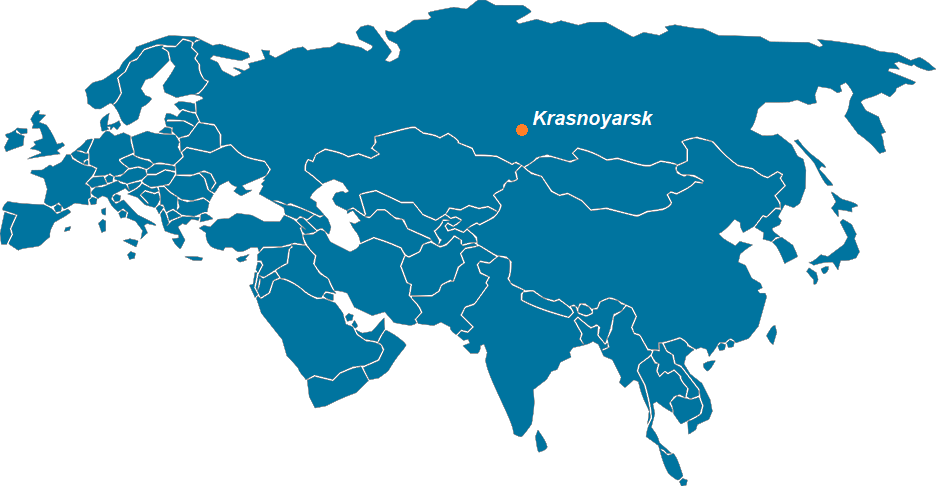
Krasnoyarsk is:
- a leading city in the Yenisey Siberia investment project
- an important cargo and passenger transportation hub with a world class International Airport Krasnoyarsk
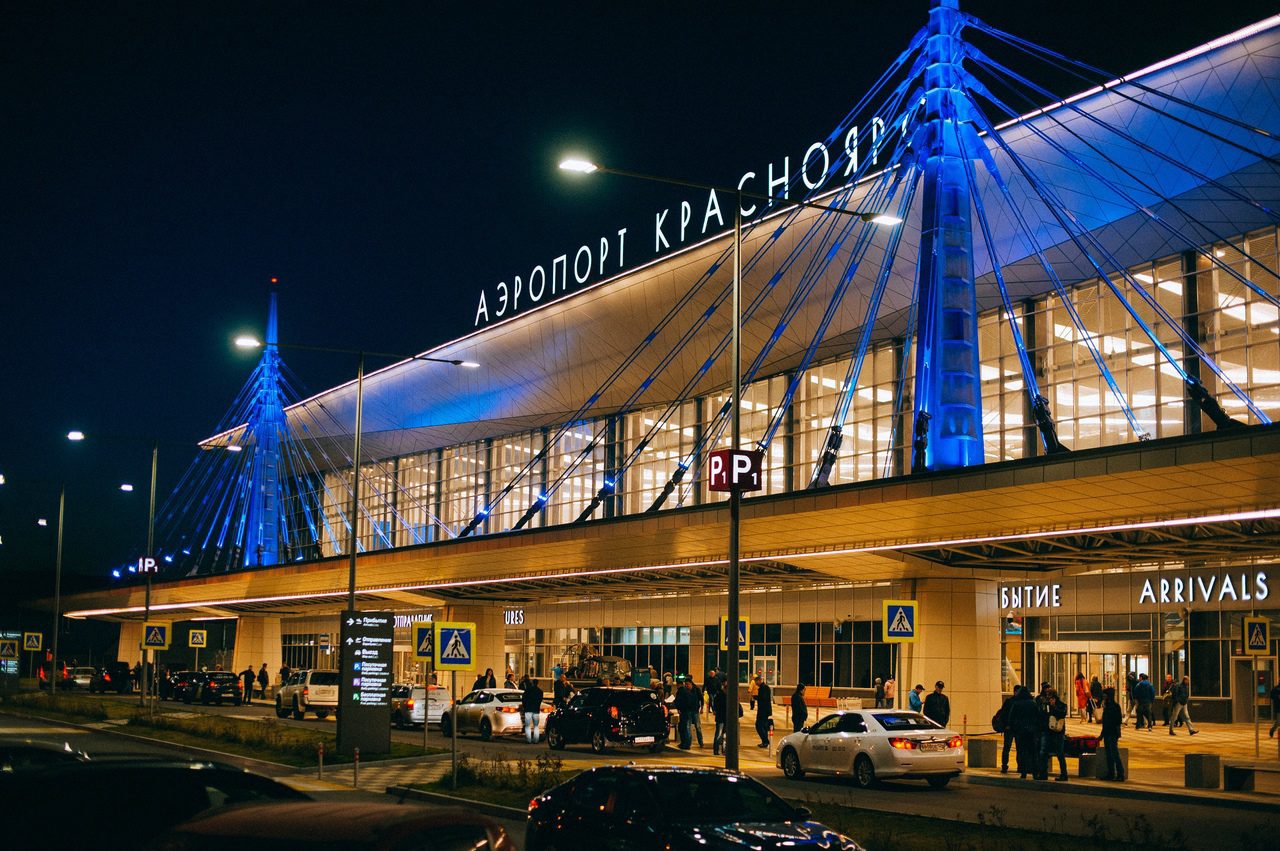
- a city bordering natural (National Park «Krasnoyarsk Stolby») and manmade (Krasnoyarsk Sea — the reservoir of the Krasnoyarsk Dam) miracles
- the territory of arts, point of interaction with the best musicians of the world (International Festival of Chamber Orchestral Music «Asia-Siberia-Europe», Victor Tretiyakov International Violin Competition)
- an active participant of international municipal cooperation with 16 sister cities in China, Mongolia, Belarus, Tajikistan, Uzbekistan, Canada, Germany, Italy and Slovakia
- the capital of the Winter Universiade 2019 and a point of attraction for athletes from all over the world, annually holding major international events in freestyle wrestling, rugby, and, of course, in various winter sports
- the inspiration of snow and ice artists from all over the world (Open Festival-Competition of Snow and Ice Sculptures «Magic Ice of Siberia»)
- the venue of highest level international forums (Krasnoyarsk Economic Forum)
- the headquarters of many leading companies from Russia and foreign countries such as the USA, France, the Netherlands, Italy, Japan, China and others
- one of the founders and an active participant of the Eurasian Regional Section of the World Organization «United Cities and Local Governments»
and a friendly city of hospitable people.
Krasnoyarsk is the city of the world!
You can walk the streets of Krasnoyarsk and meet the landmarks that will bring to your mind the images of the famous places of great cities of our planet:
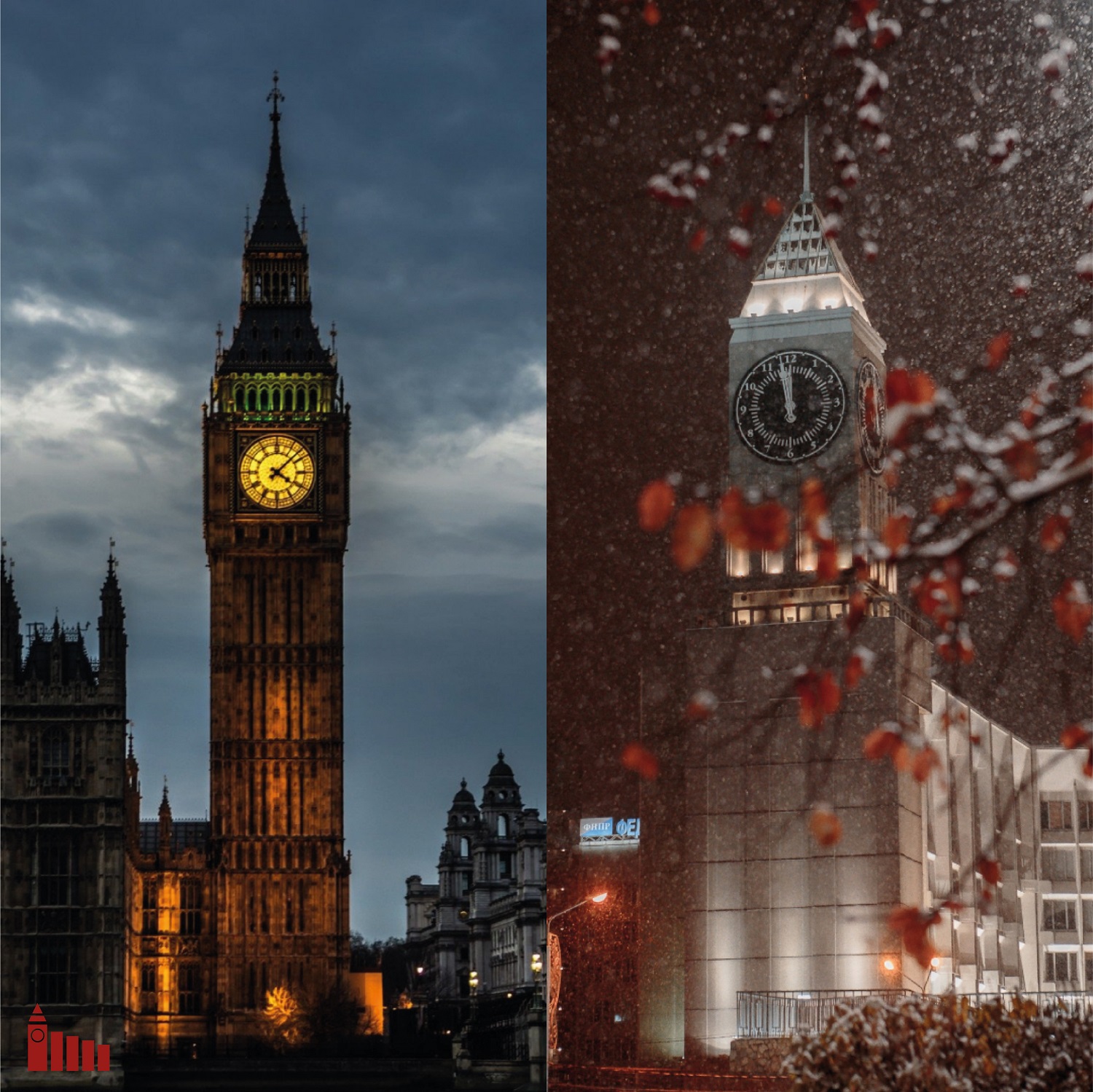 London Big Ben & City Administration Clock Tower |
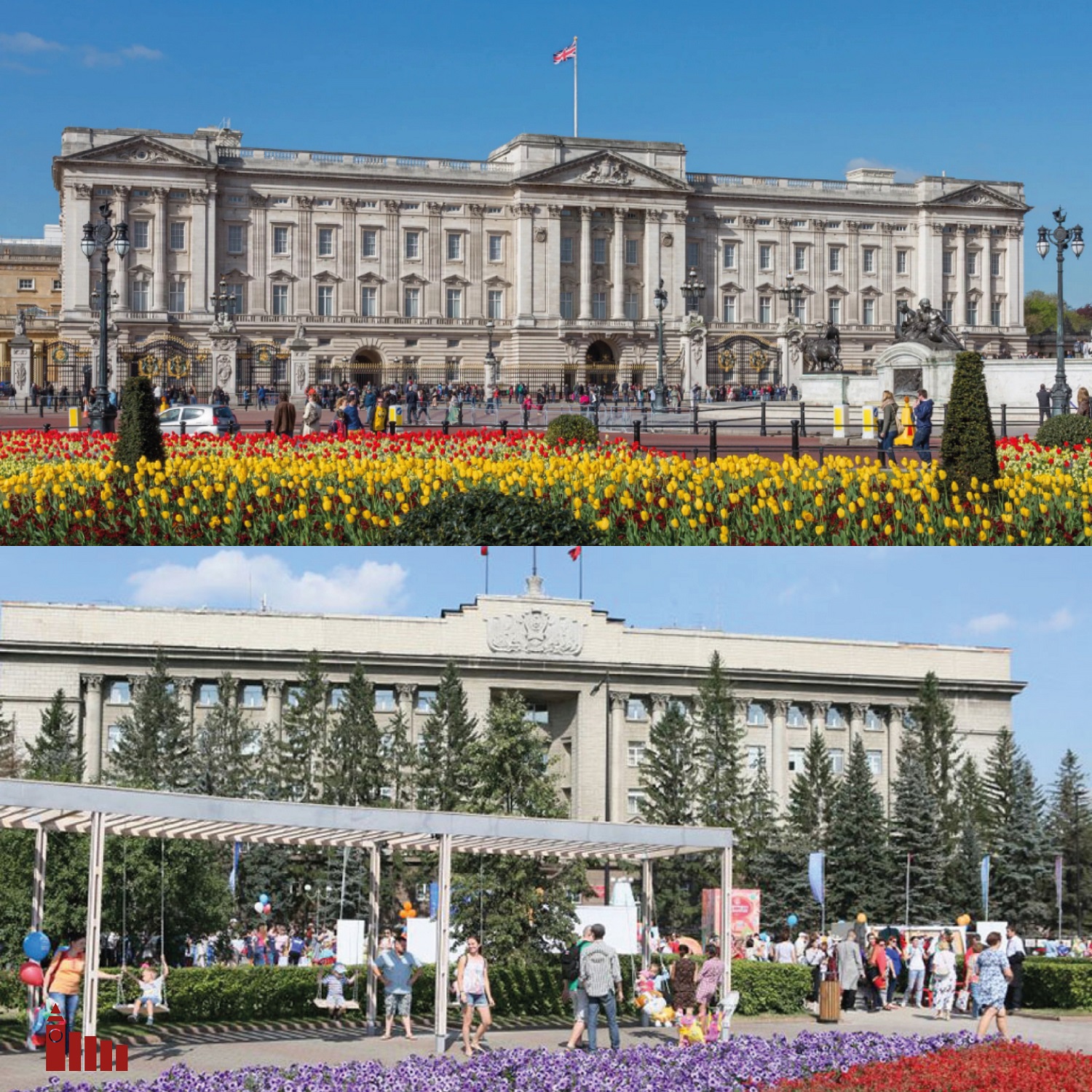
Buckingham Palace & Krasnoyarsk Governor’s Office |

Krasnoyarsk Big Concert Hall & Sydney Opera House |
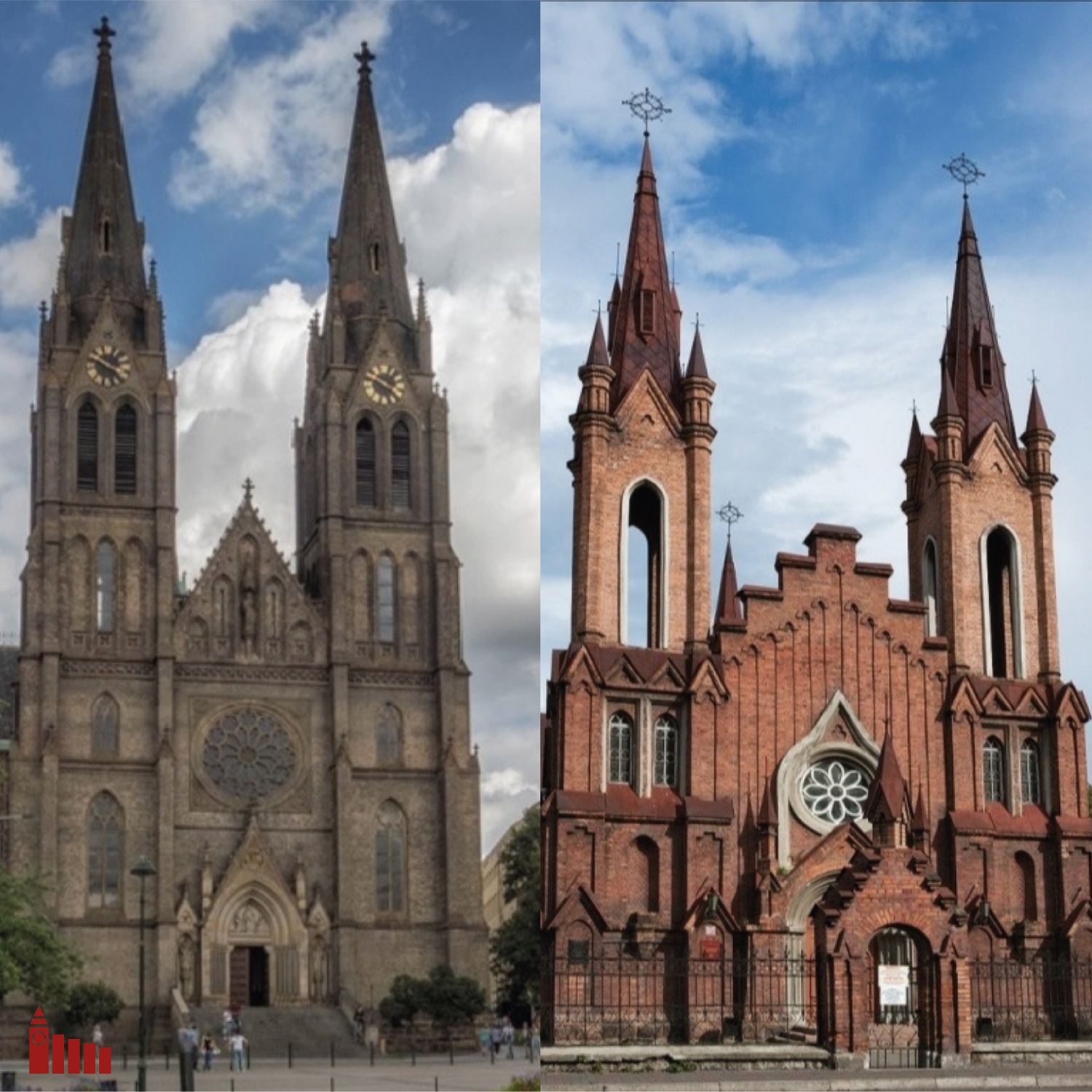
Krasnoyarsk Organ Hall & St. Stephen’s Church in Prague |
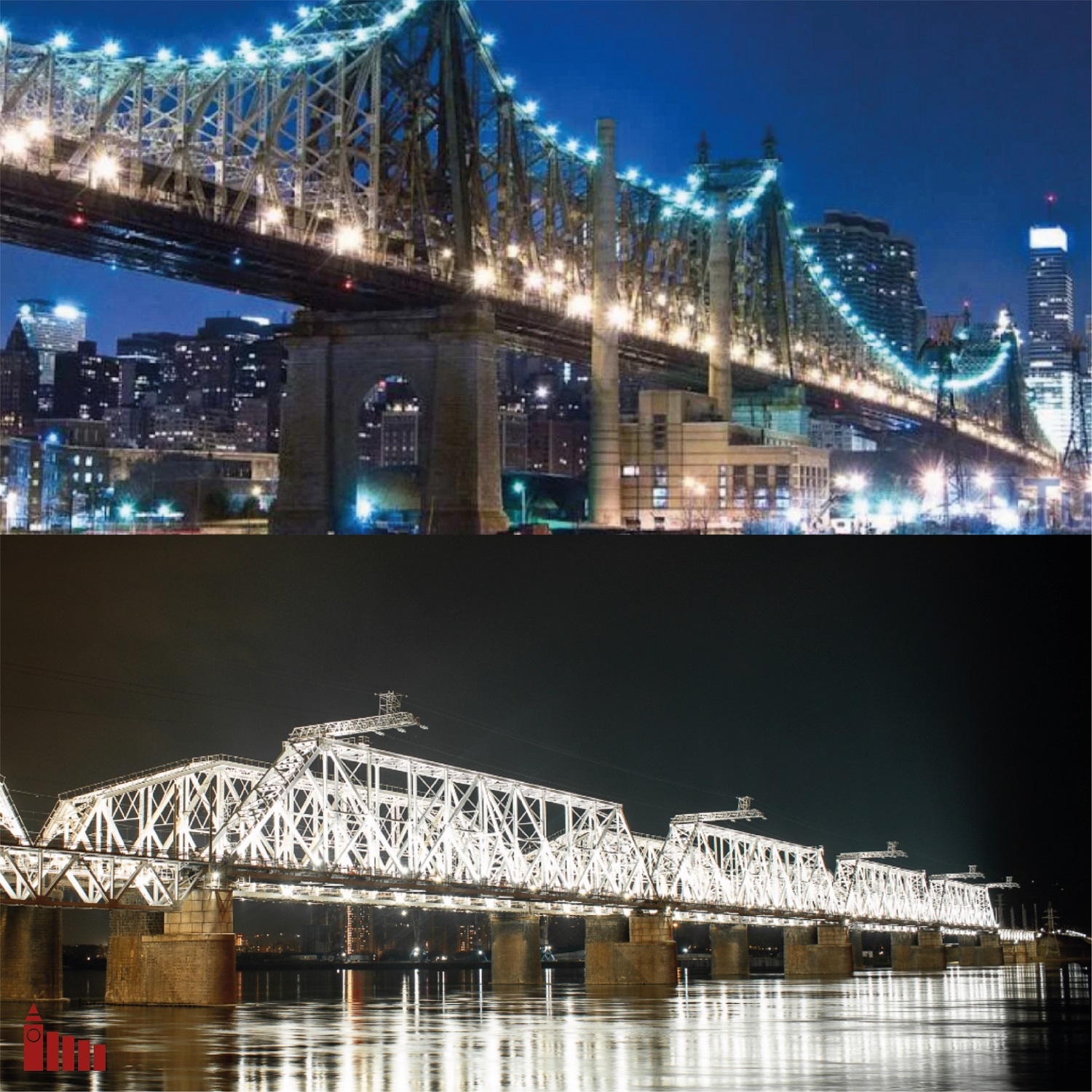
Brooklyn Bridge & Zheleznodorozhny Bridge |
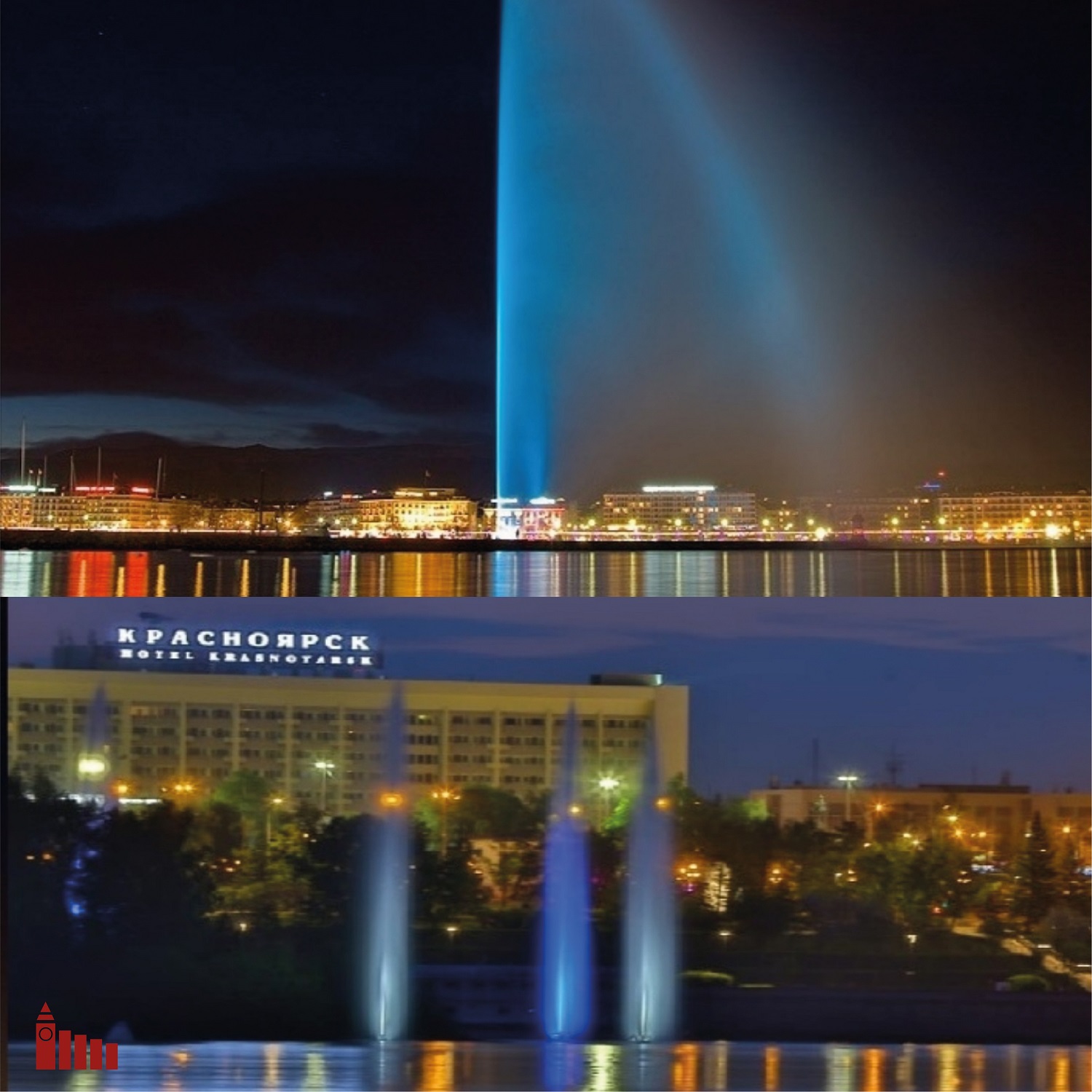
Geneva Jet d’Eau fountain & Krasnoyarsk Yenisey River fountains |
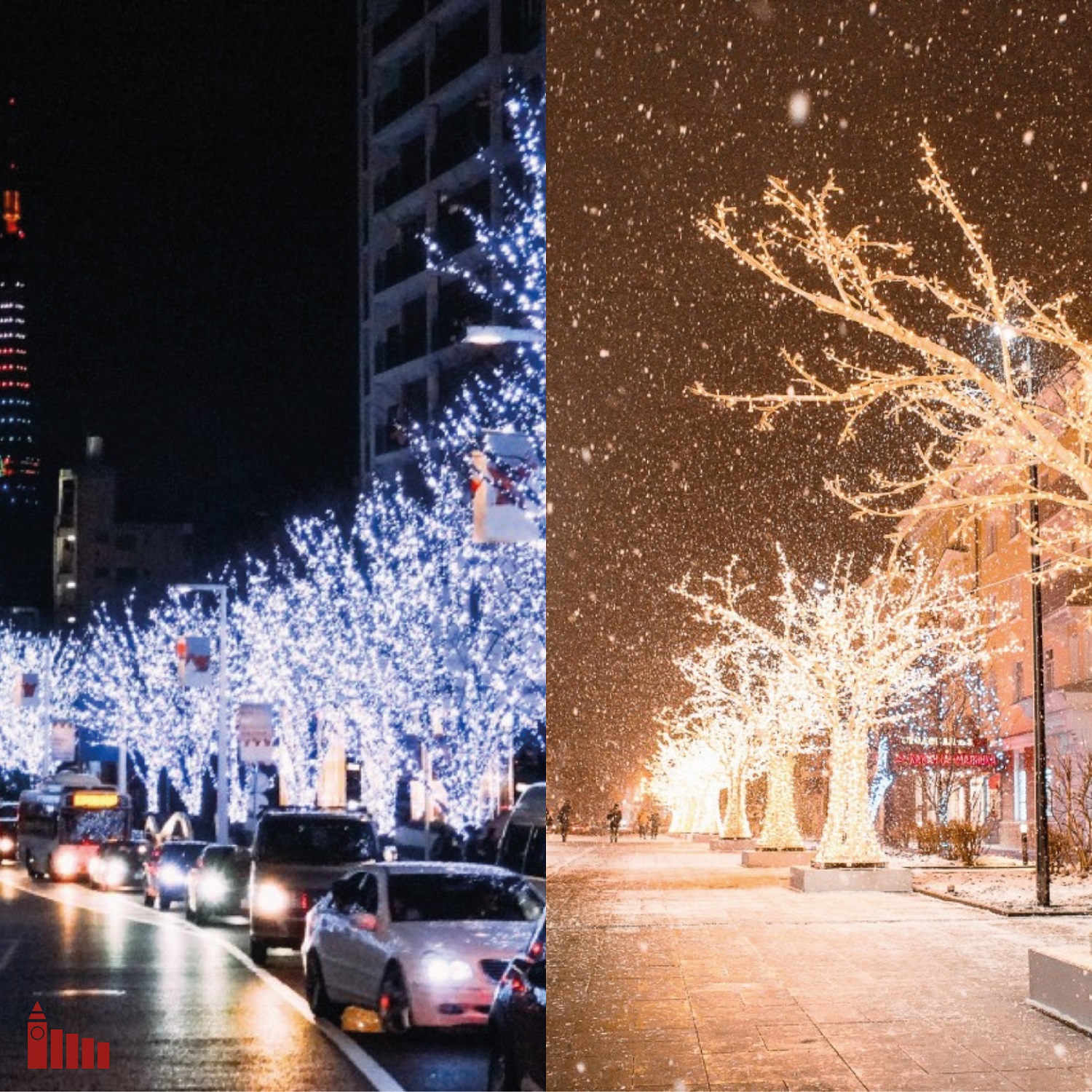
Tokyo & Krasnoyarsk light trees |
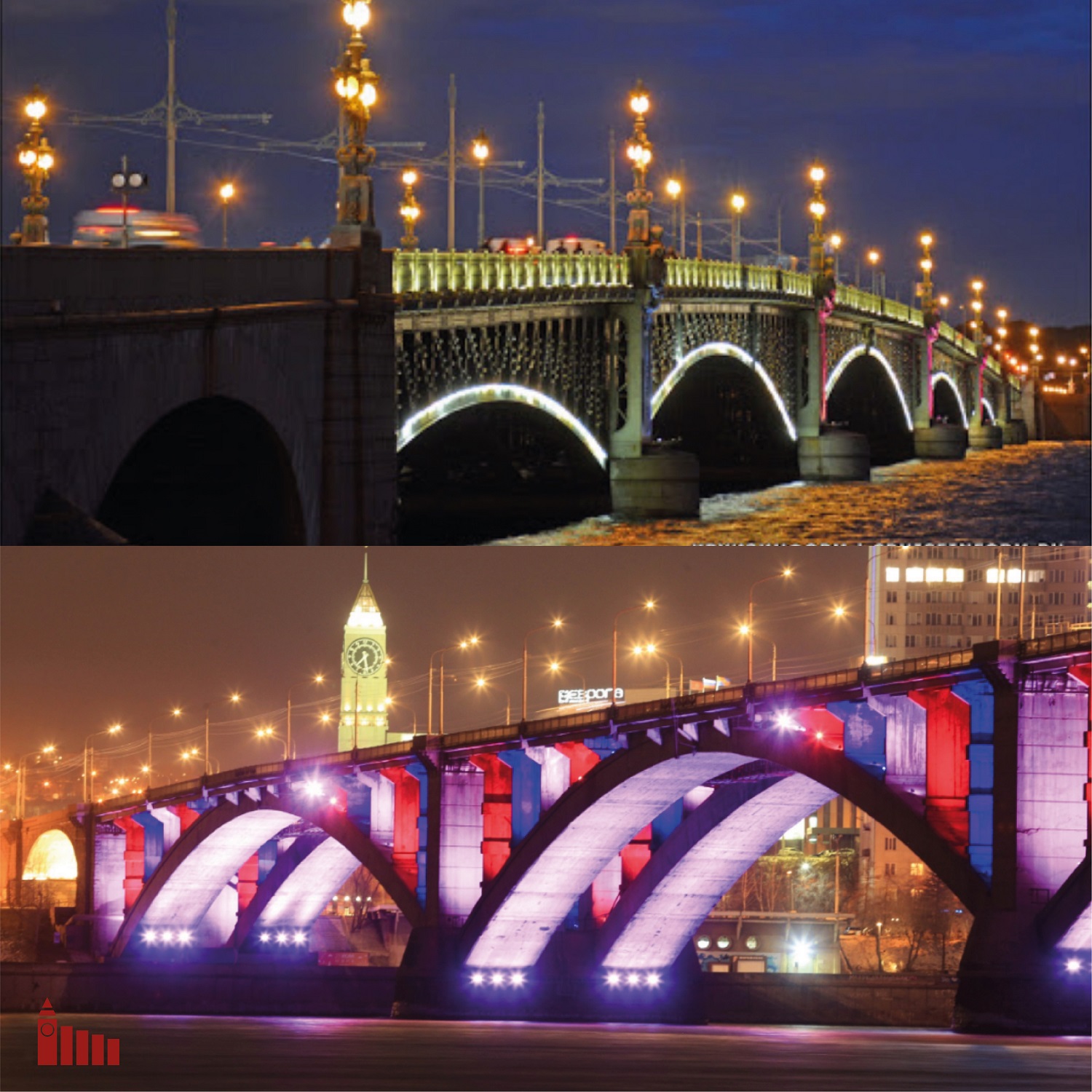
St. Petersburg & Krasnoyarsk bridge lighting |

